Rwanda Travel Guide
This is a Rwanda Travel Guide from taste2travel.com
Date Visited: May 2023
Introduction
Welcome to Rwanda, the “Land of a Thousand Hills”, although I’m sure I travelled over at least 10,000 hills!
Nestled in the heart of East Africa, this captivating country offers a wealth of natural wonders, vibrant culture, and a compelling history.

Artwork in Kigali.
From its breathtaking landscapes, to its warm and welcoming people, Rwanda is a fascinating destination which, despite its tiny size, offers a plethora of sights and attractions.

One of my favourite game parks in Africa, Akagera National Park features all of the “Big 5” animals – including elephants.
From stunning national parks such as Akagera National Park, Volcanoes National Park and the huge, lush, green expanse that is Nyungwe National Park, Rwanda is an ideal destination for nature lovers and wildlife enthusiasts.

Tea plantations cover many of the hillsides in Rwanda.
In between, the countryside of this hilly and mountainous volcanic country is covered with terraced farmlands. The slopes of many hills are used for the cultivation of tea and coffee, with rows of carefully manicured tea plants stretching to the horizon.

The hilly terrain of Rwanda is ideal for the cultivation of tea and coffee.
Rwanda’s recent, dark, past, where an estimated 800,000 Tutsi and moderate Hutus were killed during the 1994 genocide has left a lasting scar on the country.

A view of the Pfunda Tea Plantation, Rwanda.
No visit to Rwanda would be complete without reflecting upon its turbulent past. The country has made remarkable progress in the years since the tragic genocide of 1994.

Kigali Genocide Memorial is the final resting place for more than 250,000 victims of the 1994 genocide.
Today, you can visit poignant memorials and museums, such as the Kigali Genocide Memorial Centre, which provide a profound insight into the nation’s history and the strength of its people.

A shop in the Rwandan countryside.
Like a phoenix obtaining new life by rising from the ashes, Rwanda has seen explosive development and growth following the genocide, all under the steady stewardship of the long-term President Paul Kagame, who is inspired by the example of Lee Kuan Yew and the development of modern Singapore.
Could Rwanda be the Singapore of Africa? It’s certainly on track with economic and social development driving change throughout the country.

Mother and child, at Lake Ruhondo, northern Rwanda.
As part of its economic development, tourism has been prioritised, which is great news for visitors.
The Visa Policy of Rwanda (see the ‘Visa Requirements‘ section below for more details) is one of the friendliest in Africa, with everyone able to visit visa free or via a visa-on-arrival (VOA).
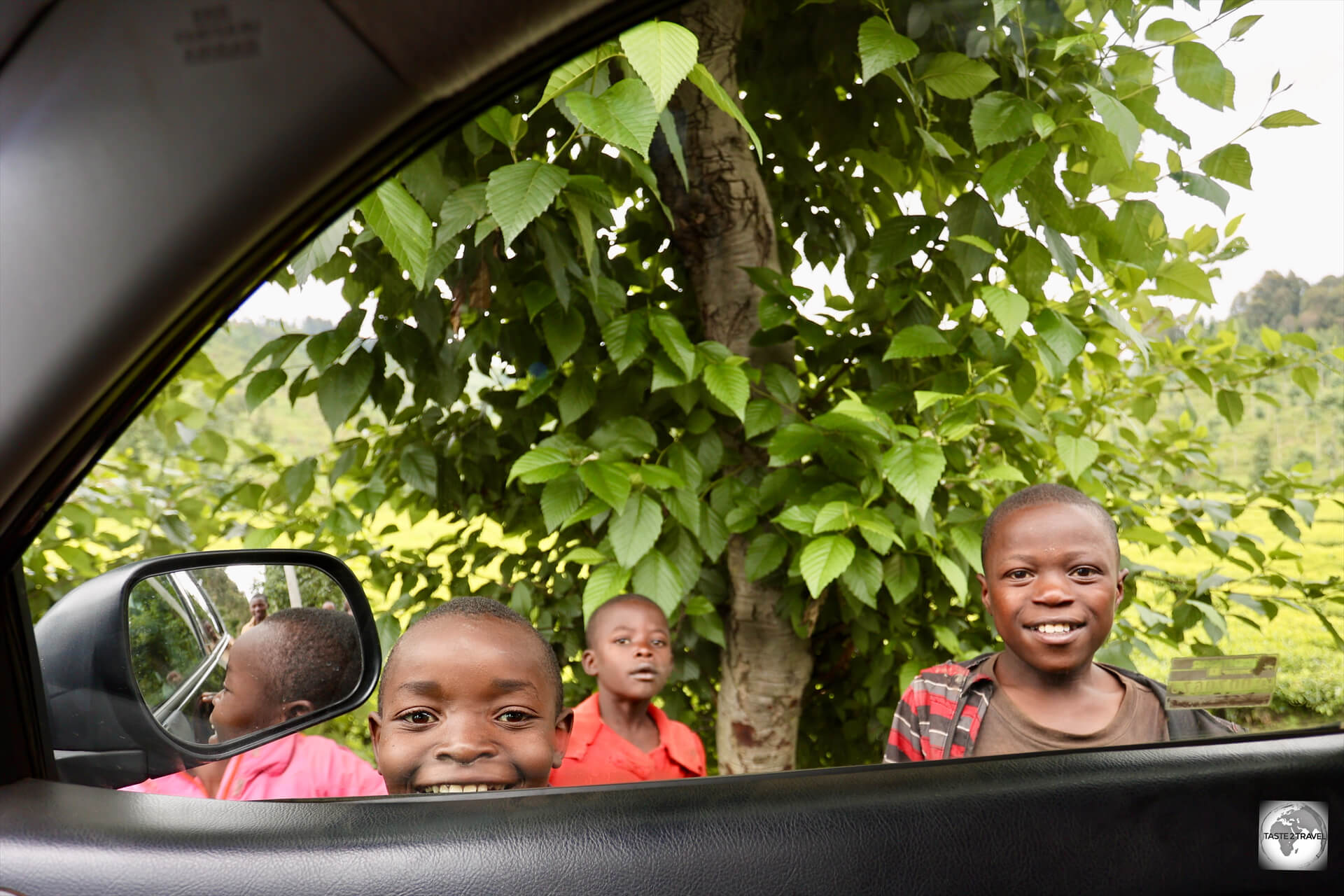
Rwandan children were always incredibly friendly, welcoming and curious about the mzungu (white man) in their midst.
I thoroughly enjoyed my time in Rwanda and cannot wait to return to explore more of this African gem.
Rwanda is a fascinating and diverse African destination which is clean, efficient, corruption-free, organised, safe, friendly and absolutely visitor-friendly.
Karibu Rwanda, welcome to Rwanda!
Location
Kigali, Rwanda
Rwanda is a landlocked country located in the heart of East Africa. It is bordered by Uganda to the north, Tanzania to the east, Burundi to the south, and the Democratic Republic of the Congo to the west.
Despite its small size, Rwanda packs a diverse range of landscapes and geographical features within its borders.
The country is renowned for its picturesque rolling hills, earning it the nickname “Land of a Thousand Hills.” These verdant hills, covered with lush vegetation and terraced farms, create a captivating and scenic landscape that stretches across the entire country.
The undulating terrain provides breathtaking views and unique opportunities for outdoor exploration.
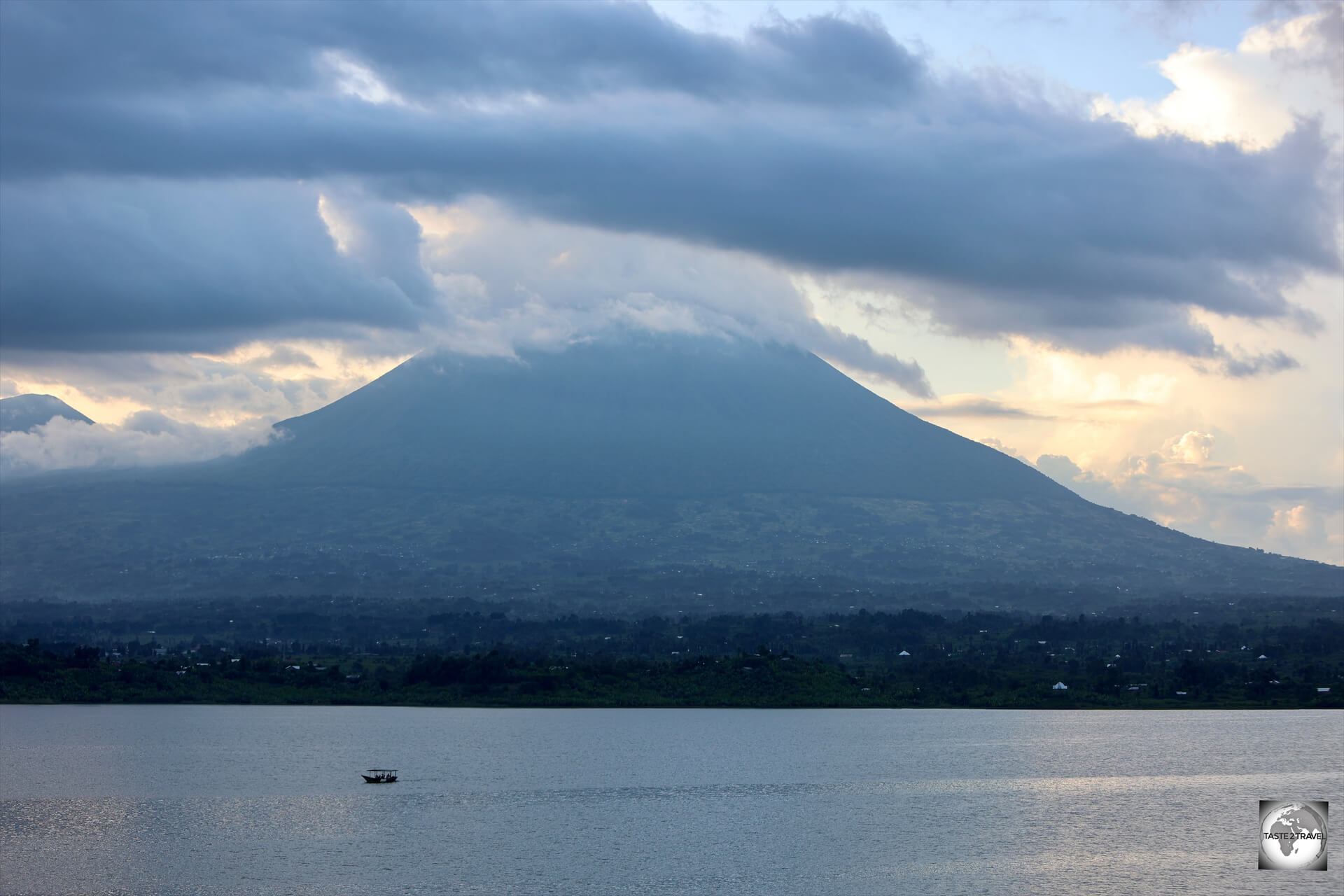
The Virunga Mountains form a volcanic chain which defines the border between Rwanda, Uganda and the Democratic Republic of Congo (DRC).
Rwanda is also known for its volcanic peaks. The Virunga Mountains in the northwestern part of the country are a volcanic chain that extends into the neighbouring countries of Uganda and the Democratic Republic of the Congo (DRC).

The lush, hilly, terrain of Rwanda is ideal for agriculture.
The towering peaks, including Mount Karisimbi and Mount Bisoke, offer stunning panoramas and serve as a habitat for the endangered mountain gorillas.
In addition to its hills and volcanoes, Rwanda is home to numerous lakes.

A view of Lake Kivu, which defines the border between Rwanda and the DRC.
Lake Kivu, located in the western part of the country, is one of the African Great Lakes and forms part of the border with the Democratic Republic of the Congo.
The lake’s deep blue waters provide a serene and picturesque setting, surrounded by lush green hills and charming lakeside towns.
Rwanda’s capital and largest city is Kigali, situated in the central part of the country.
Kigali is a vibrant and modern city, known for its cleanliness, efficient infrastructure, and friendly atmosphere. It serves as the cultural, economic, and administrative hub of Rwanda, offering a blend of cosmopolitan amenities and Rwandan traditions.
Overall, Rwanda’s location in the heart of East Africa, along with the country’s visitor-friendly Visa Policy (see the ‘Visa Requirements‘ section below), makes Rwanda an ideal gateway to explore the remarkable beauty of East Africa.
People

The Rwandans, generally, are courteous, polite, respectful and friendly.
The people of Rwanda, known as Rwandans, are warm, hospitable, and resilient.
The country is home to a diverse population with several ethnic groups, including the Banyarwanda, who make up the majority of the population, as well as the Batwa, Tutsi, and Hutu communities.

Mother and child at Lake Ruhondo.
The official languages of Rwanda are Kinyarwanda, French, and English. Kinyarwanda is the most widely spoken language and serves as a unifying force among the different ethnic groups.
English has been increasingly emphasised in recent years as part of Rwanda’s educational and economic development, contributing to a growing English-speaking population.

Everywhere I travelled in Rwanda, I was greeting with warm smiles and lots of kindness.
Rwandans are known for their strong sense of community and unity.
Despite the tragic events of the 1994 genocide, the people have worked tirelessly towards reconciliation and rebuilding their nation.
This collective spirit of resilience and determination has played a crucial role in Rwanda’s remarkable progress and transformation over the years.
Hospitality is deeply ingrained in Rwandan culture. Visitors to the country are often struck by the genuine warmth and friendliness of the Rwandan people.

The friendly Rwandans always greeted me with a warm smile.
The people of Rwanda have a deep connection to their land and natural surroundings.
Agriculture is a primary occupation for many, with farming being a fundamental part of their way of life. Large parts of the hilly countryside are covered with both tea and coffee plantations.
Rwandans are known for their respect and kindness towards others, and visitors often feel a sense of belonging and acceptance while exploring the country.
Overall, the people of Rwanda embody resilience, unity, and a commitment to building a better future. Their warm hospitality, vibrant culture, and determination to overcome challenges make Rwanda an inspiring and captivating destination to explore.
Flag

The flag of Rwanda consists of a horizontal tri-colour of light blue (double width), yellow and green; charged with a sun-yellow sun in the upper-fly side corner.

Rwandan flag souvenir fridge magnets.
- The top stripe is the colour of sky blue, which represents happiness and peace. It represents the hopes and aspirations of the Rwandan people for a peaceful and prosperous future.
- The middle stripe is yellow, which represents the country’s economic potential and development. It signifies the country’s commitment to progress and the pursuit of a brighter future for its citizens.
- The bottom stripe is green, which represents the lush and fertile landscape of Rwanda. It symbolizes the country’s agricultural heritage, emphasizing the importance of agriculture in the lives of the Rwandan people.
- The yellow sun represents enlightenment.
Currency

The Rwandan franc is the official currency of Rwanda.
The currency of Rwanda is the Rwandan franc, which has the international currency code of RWF.
The currency is denoted by the symbol “RWF” or “RF” and is further divided into smaller units called centimes, although centime coins are no longer in circulation.
Banknotes, which are issued by the National Bank of Rwanda, are available in denominations of RWF 500, 1000, 2000 and 5000.
The highest denomination note – RWF 5,000 – is currently equal to just US$4.17! For this reason, digital payments have become very popular in Rwanda.

The 5,000 Rwandan franc banknote features the Mountain Gorilla.
Exchange Rate
Currently (September 2023), the exchange rate between the US dollar and the Rwandan franc is:
USD$1 = RWF 1,198.86
To check the current exchange rate, please click here.

The Rwandan franc (RWF) is the official currency of Rwanda.
Credit Cards
Many businesses accept credit and debit cards, with both Mastercard and Visa being widely accepted.
ATMs
ATMs can be found in Kigali and nearly all major cities. I never had problems to access cash in Rwanda.
Costs

Menu prices at Bourbon Coffee, one of the best café chains in Kigali.
Day-to-day costs in Rwanda are very reasonable, however costs relating to most tourist activities are very unreasonable.
As an example of high costs imposed for tourist activities, you can currently view the Mountain gorillas on the slopes of the Virunga Mountains, which span three countries – Rwanda, Uganda and the Democratic Republic of Congo (DRC).
However, the cost for visiting these gorillas varies greatly, with a Gorilla permit in each country costing:
Likewise, in all national parks, foreigners are charged an entrance fee of at least US$100 – versus locals who are charged RWF 15,000 (USD$12.50).
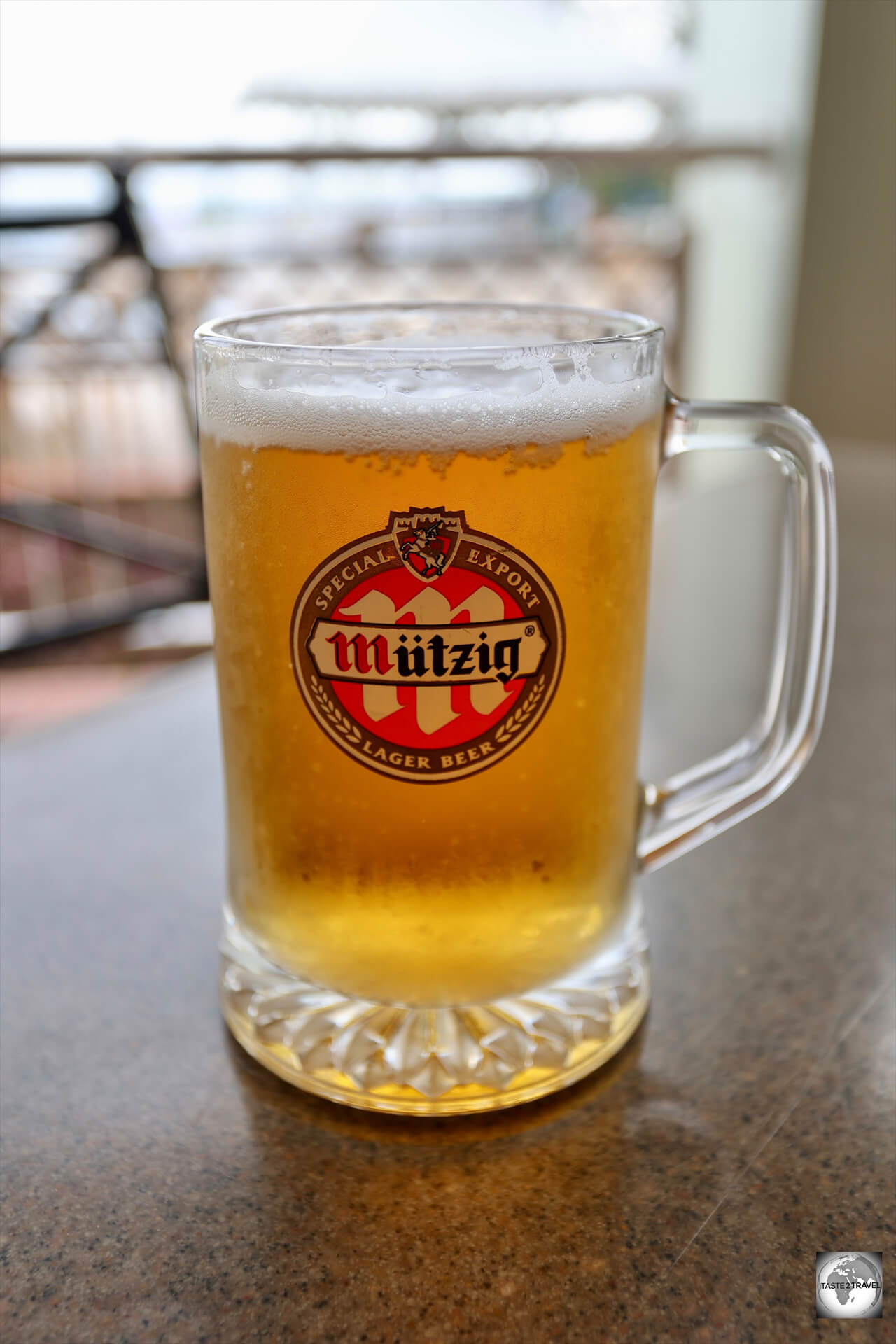
A glass of refreshing Mützig beer will not break the bank in Rwanda.
Sample costs in Rwanda:
- Meal for one (budget restaurant): 3,500 RWF (US$2.90)
- Beef Burger meal at Bourbon Coffee in Kigali: 6,000 RWF (US$5.00)
- Eggs Benedict at Bourbon Coffee in Kigali: 5,000 RWF (US$4.15)
- Mützig Beer (0.5L): 1,500 RWF (US$1.25)
- Cappuccino at Bourbon Coffee in Kigali: 3,000 RWF (US$2.00)
- Soda drink at Bourbon Coffee in Kigali: 1,500 RWF (US$1.25)
- Mineral Water (.5L) at Bourbon Coffee in Kigali: 1,000 RWF (US$0.83)
- Car Rental from Kigali Car Rentals: US$40
- 1L of petrol: RWF 1,550 RWF (US$1.30)
- A standard room (single) at the 4-star Hotel des Mille Collines: US$165
- A standard room at the excellent Court Boutique Hotel in Kigali: US$120
- A budget hostel bed in Kigali: US$10
Wi-Fi

While in Rwanda, I used an MTN pre-paid SIM card.
MTN offer daily, weekly and monthly data packages at very reasonable rates.
A local SIM card is invaluable if you’ll be doing a self-drive and relying on navigation.
While driving, I always use, and recommend, the Waze navigation app, which highlighted all of the many speed cameras which are found every 1-2 km on Rwanda’s highways. Google maps does not offer such a feature!
Waze is an invaluable navigation device that can save you a fortune, with fines from the speed cameras costing around US$25.
Sightseeing

Sightseeing highlights in Rwanda include a number of excellent national parks.
Kigali City

The domed roof of the Kigali Convention Centre, which is inspired by the roof of the former Royal Palace, is illuminated each evening with the national colours.
Despite bearing the brunt of the genocide’s unspeakable horrors in 1994, Kigali has been the centre of Rwanda’s nation-building efforts since that time and has seen massive amounts of state and foreign investment pouring in over the past two decades.
From the moment you arrive in Kigali, it’s clear that this is not your typical African capital city.
From the spotlessly clean streets, which are lined with manicured hedges and gardens, to the clean footpaths which pedestrians amble along, Kigali is a clean, green and orderly city.
Speed cameras, which are placed every 1-2 km along all main roads ensure drivers do not break the speed limit. Low speed limits, with accompanying speeding fines, has caused an uproar in Kigali with some motorists saying that the speed limits (40-60 km/h) around the city are unreasonable.
Either way, this is one of the cleanest, greenest, and most pleasant cities you will experience in all of Africa. It was a pleasure using Kigali as a hub for my explorations in the region.
The rebirth of the capital has seen a cosmopolitanism arrive in the city and Kigali now boasts a slew of new skyscrapers, several international hotels and a host of excellent eating options.
Few people leave Kigali without being impressed by this plucky and charismatic survivor. And being right in the centre of the country, it’s a great base from where to organise your trip around Rwanda.
I look forward to the day when I will once again return to Kigali!
Kigali Genocide Museum

Inaugurated in 2004, the Kigali Genocide Memorial is the final resting place for more than 250,000 victims of the 1994 genocide.
The Kigali Genocide Memorial serves as a poignant reminder of the 1994 genocide in Rwanda.
It provides a comprehensive history of the genocide and pays tribute to the victims. The memorial includes a museum, gardens, and a mass grave where over 250,000 victims are buried.

A group of school girls, praying at the Kigali Genocide Memorial.
During the span of 100 days, an estimated one million Tutsis, and moderate Hutus, were systematically butchered by the Interahamwe army.
This memorial honours the estimated 250,000 people buried here in mass graves and also has an excellent exhibition that tries to explain how it was that the world watched as the 1994 genocide unfolded.
One of many Dark Tourism sights in Rwanda, the Kigali Genocide Memorial is an intensely powerful and moving memorial for which you should dedicate at least half a day.

A view of the Kigali Genocide Memorial in Kigali.
Unfortunately, photography inside the museum is prohibited, unless you seek prior approval from a government ministry.
The museum exhibits are very powerful and moving. It’s inconceivable how such an atrocity could have taken place and even more inconceivable how the international community stood by and watched without taking any action!
All of this is dealt with through the many moving exhibits.
For those who can remain dispassionate while viewing the displays, you’ll find that it will all catch up with you at the section that remembers the children who fell victim to the killers’ machetes.
Life-sized photos are accompanied by intimate details about their favourite toys, their last words and the manner in which they were killed. Some enfants were simply thrown, forcefully, against brick walls!
The memorial concludes with sections on the search for justice through the international tribunal in Arusha as well as the local gacaca courts (traditional tribunals headed by village elders).
Outside, vast concrete slabs cover the mass graves that are the final resting place for more than 250,000 people killed during the genocide.
Also onsite is a very good café, which serves lunch buffets (2,500 RWF), snacks, juices and very good barista-made coffee.
Access:
The Kigali Genocide Memorial is located in the northern Kisozi district, which is a short taxi ride from the centre of Kigali.
While there is no entrance fee, donations are appreciated.

During my visit to the Kigali Genocide Memorial, I was guided by Peter and Joyce, two representatives from Youth Dialogue for Peace and Development – an organisation whose mission is:
“to empower the community with skills, knowledge and information for successful participation in peace building and community development activities, focusing on youth and the population in general”.
As per their website, the aims of the organisation are:
- To reinforce youth capacities and the population in general in conflict management and critical thinking through training, debates, dialogues and games;
- To sensitise and support youth and the population in general for civic engagement, job creation and active participation in socio-economic activities for self-reliance and community development;
- To sensitise and support the youth and the population in general for the culture of collaboration generations, in community and country development.
The organisation works with many of the youth who were both traumatised and made orphans as a result of the genocide.
The fact is that the slaughter of so many adults during the genocide left a large percentage of children as orphans.
Organisations such as YDPD are working with orphans to support them and allow them to further integrate into the community.
If you would like to learn more, or offer any support or help, you can contact the organisation through their website.
Presidential Palace Museum / Rwanda Art Museum

Used up until the 1994 genocide, the former Presidential Palace, which is now a museum, is located on the eastern outskirts of the city, close to the airport.
Located near the airport, on the eastern outskirts of the city, this former Presidential Palace served as the residence of Juvenal Habyarimana, the former president of Rwanda.
On the 6th of April, 1994, while returning from a meeting in Burundi with the president of Burundi, Cyprien Ntaryamira, Juvenal Habyarimana’s plane was shot down while on final approach to Kigali Airport, resulting in the deaths of all on board, including the two presidents.

Wreckage from Juvenal Habyarimana’s presidential plane can still be seen where it was shot down – behind the Presidential palace.
In what could only be described as an ironic tragedy, his plane crash landed directly behind the rear wall of his palace garden.
The wreckage of the plane still remains in place, behind the palace walls, and can be visited with a museum guide.
While the perpetrators were never caught, this single act proved to be a rallying call for Hutu extremists and helped trigger the 1994 genocide.
It is widely believed that the plane was shot down by Hutu militia, who then used the event as (false) justification for launching the genocide against the Tutsi.
The genocide claimed the lives of more than 800,000 civilians, mostly Tutsi.
The plane apparently crashed into a pond enclosure, which housed a large Python, which managed escape and has never been seen since!

An abandoned swimming pool in the garden of the former Presidential Palace in Kigali.
Like so many places in Rwanda, photography isn’t allowed inside the palace, which now houses the Rwanda Art Museum, however you are free to photograph the extensive gardens, which includes an abandoned swimming pool.
Belgium Peacekeepers Memorial

The bullet-sprayed building, in which the Belgium soldiers died, now houses a small exhibition on the genocide.
As a result of the 1994 Rwandan Genocide, there are plenty of Dark Tourism sights in Rwanda, including the Belgium Peacekeepers Memorial in downtown Kigali.
The assassination of presidents Juvénal Habyarimana and Cyprien Ntaryamira in the evening of April 6, 1994 was the proximate trigger for the Rwandan genocide, which resulted in the murder of approximately 800,000 Tutsi and a smaller number of moderate Hutu.

Ten, granite-stone, columns serve as a memorial to the ten Belgian UN Peacekeepers who were murdered in the early days of the 1994 genocide.
The first few days following the assassinations included a number of key events that shaped the subsequent course of the genocide.
These included: the seizing of power by an interim government directed by the hard-line Akazu clique; the liquidation of opposition Hutu politicians; the implementation of plans to carry out a genocide throughout the country; and the murder of United Nations peacekeepers, contributing to the impulse of the international community to refrain from intervention.
Following a military takeover of the government and the killing of the Prime Minister, Agathe Uwilingiyimana, the presidential guard captured the fifteen UN peacekeeping troops from UNAMIR, who had been tasked with protecting the Prime Minister.

The ten Belgium soldiers, who were huddled in the corner of this former classroom, were killed instantly by a grenade.
The peacekeepers were led to an army camp in downtown Kigali, apparently for their own safety. However, once at the camp, it was clear that the peacekeepers were far from ‘safe’.
Five out of the fifteen peacekeepers were Ghanaian soldiers who were quickly set free.
The other ten were Belgians soldiers who were shot and hacked with machetes and eventually, while huddled in the corner of a classroom, killed by a grenade.
In 2007, in a court in Brussels, Major Bernard Ntuyahaga was convicted of the Belgians’ murders.

The former blackboard, in the classroom where the soldiers died, is now used as a memorial.
Today, the bullet sprayed class room (where the soldiers died) serves as a memorial to the atrocity.
Outside, a memorial comprised of 10 granite-stone columns commemorate the 10 soldiers, with horizontal cuts in the columns representing the age of each soldier.
Northern Province

The lush mountains, which surround Lake Ruhondo, are intensively farmed.
Lake Ruhondo
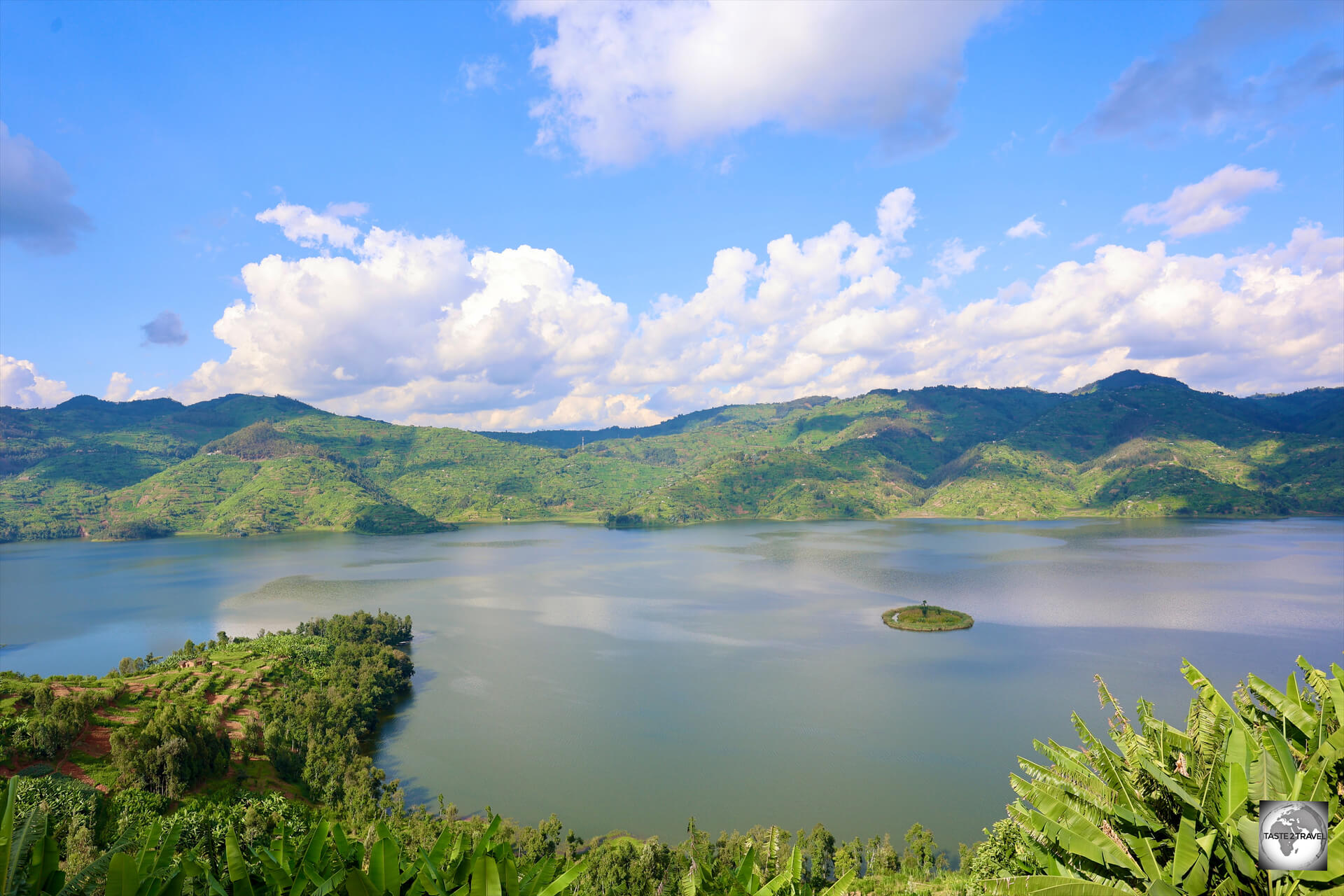
A highlight of the Northern Province of Rwanda, beautiful Lake Ruhondo is located at 1,640 metres (5,380 feet) above sea level.
Lake Ruhondo is a beautiful freshwater lake located in the northern part of Rwanda.
It is part of the volcanic region known as the Virunga Mountains and is situated at an elevation of approximately 1,640 meters (5,380 feet) above sea level.
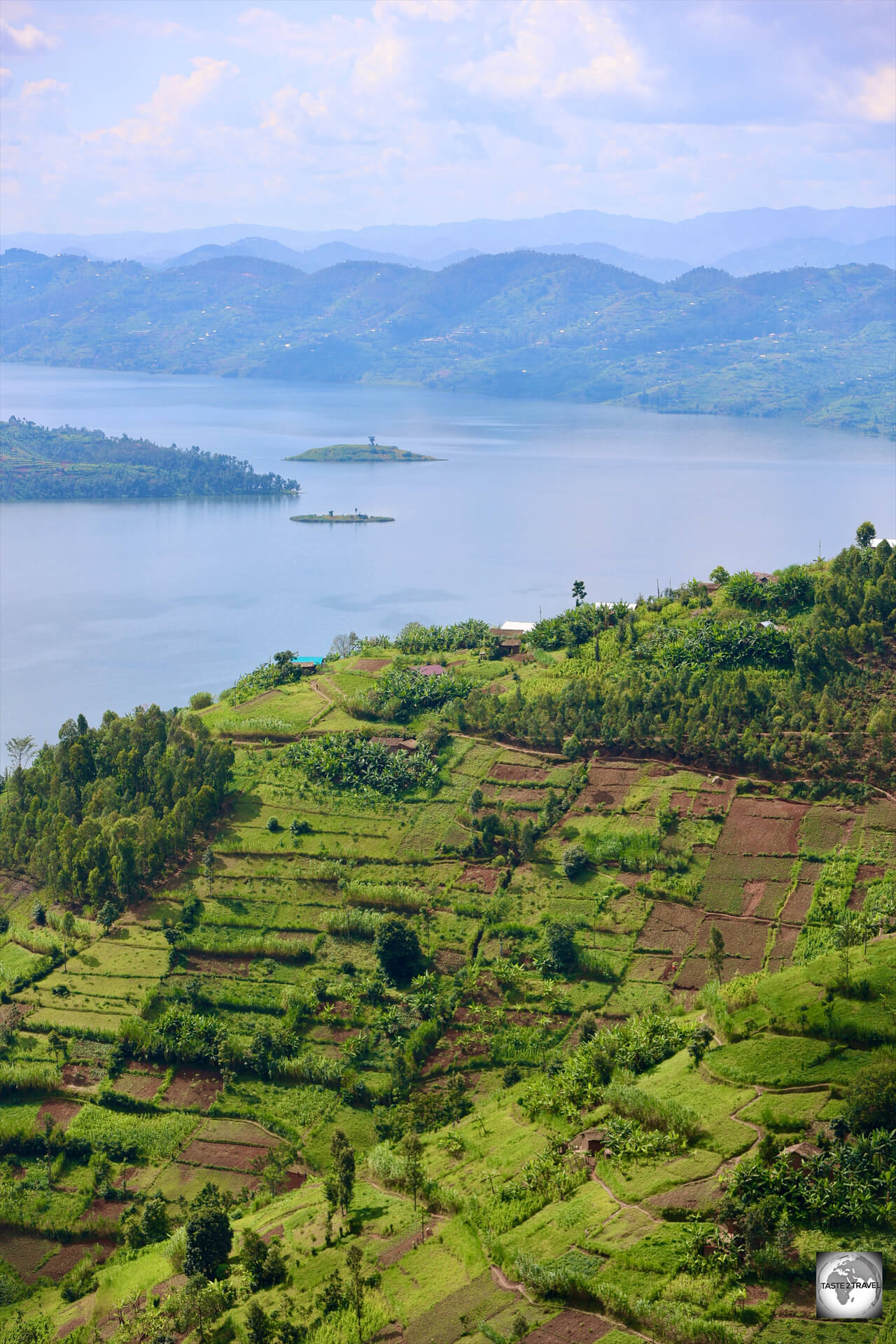
The fertile hills which surround the shores of Lake Ruhondo are ideal for farming.
I explored the lake in my Toyota RAV4 rental car. The only access is via gravel roads, with some of the remoter roads being rough tracks which are suitable only for 4WD vehicles.

A view of the stunningly beautiful Lake Ruhondo, from my remote accommodation at ‘My Hill Eco Lodge’.
The lake is relatively small, covering an area of about 37 square kilometres (14 square miles), but it holds immense natural beauty and tranquility.

The blissfully serene, Lake Ruhondo.
One of the remarkable features of Lake Ruhondo is its stunning surroundings. The lake is surrounded by steep hills and mountains covered with lush green vegetation.

The lush hills surrounding Lake Ruhondo are intensively farmed.
The Virunga Mountains, including the nearby Volcanoes National Park, add to the breathtaking scenery.

A boat load of school children, crossing Lake Ruhondo.
The combination of the deep blue waters of the lake and the verdant hills creates a picturesque landscape that is perfect for photography and nature appreciation.
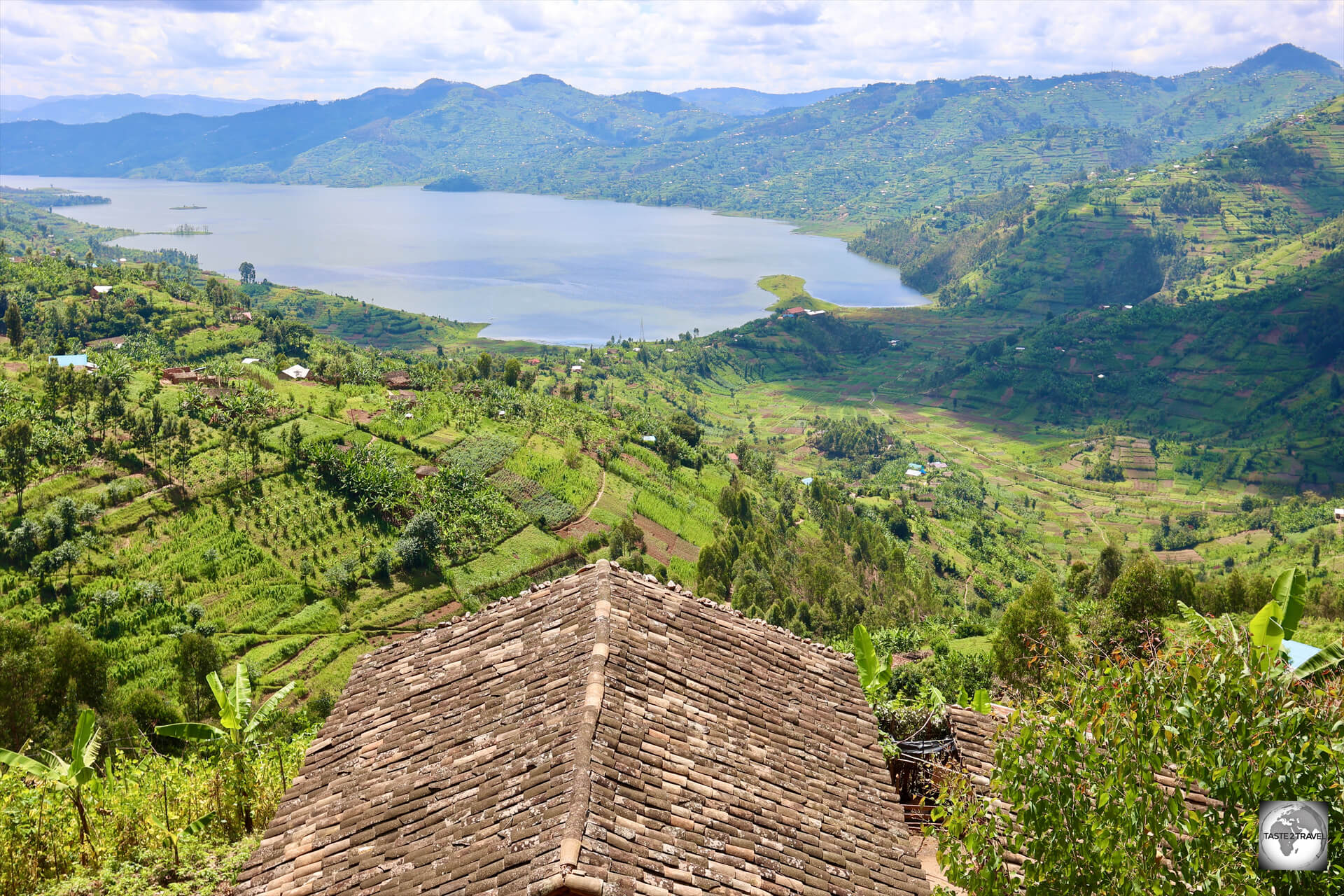
A panoramic view of Lake Ruhondo, from the gravel road which runs along the top of a ridge, high above the lake.
The overall atmosphere of Lake Ruhondo is one of tranquility and natural beauty. Located off the main northern highway, the lake is a hidden gem in Rwanda’s natural scenery.
Lake Burera

Running alongside Lake Ruhondo, Lake Burera is one of two lakes in the Northern Province of Rwanda.
Lake Burera is a picturesque freshwater lake located in the Northern Province of Rwanda, adjacent to Lake Ruhondo.
The lake is situated at an altitude of approximately 1,503 metres (4,931 feet) above sea level and is surrounded by the Virunga Mountains, creating a stunning backdrop.

A picturesque scene at Lake Burera.
Covering an area of about 77 square kilometres (30 square miles), Lake Burera is the second-largest lake in Rwanda, after Lake Kivu.
It is known for its natural beauty and tranquility, offering visitors a serene and peaceful environment to enjoy. The lake’s deep blue waters are surrounded by rolling hills covered in lush green vegetation, creating a scenic landscape.
Musanze (Ruhengeri)
Musanze, formerly known as Ruhengeri, is a vibrant town located in the northern part of Rwanda, nestled in the scenic foothills of the Virunga Mountains, offering breathtaking views and a pleasant climate.
The town serves as the regional capital and is the gateway to the Volcanoes National Park, home to the endangered mountain gorillas.
Musanze serves as a base for Gorillas treks which should be booked many months in advance and cost US$1,500!
Gorilla Trekking in 1992!

Flashback to my Gorilla trek in Zaire in 2002.
I was fortunate enough to do a Gorilla trek in 1992, in what was then Zaire (now Democratic Republic of Congo), for what was, then, the outrageously expensive sum of US$50. How times (and prices) have changed!
I was fortunate enough to accompany a National Geographic film crew, who were filming a gorilla documentary. The lead cameraman had worked on the movie ‘Gorillas in the Mist‘.
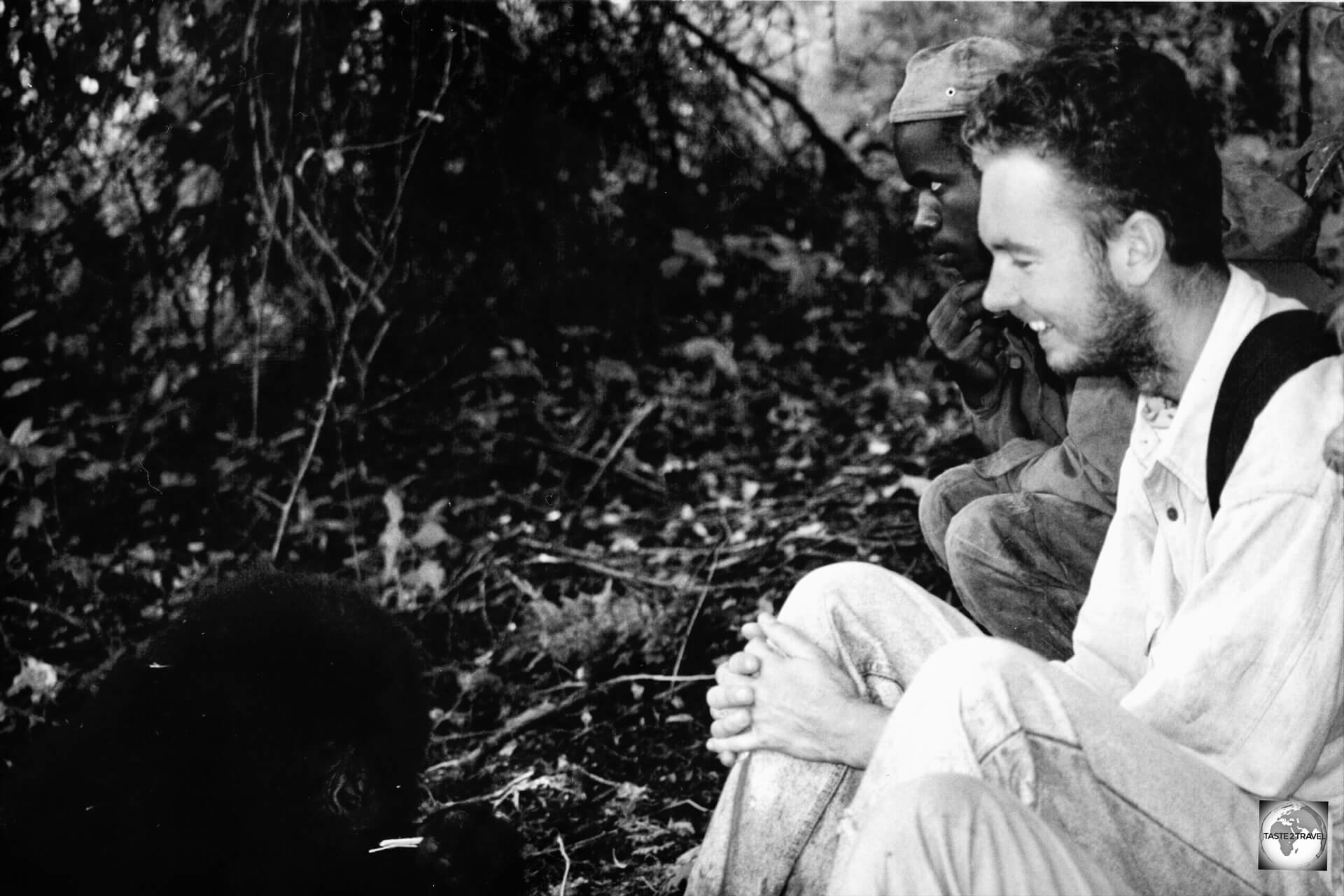
Flashback to my Gorilla trek in Zaire in 2002, when I was just a 25-year-old-kid with a dream!
We spent many hours with one group of gorillas which was one of the most amazing wildlife interactions I’ve had the privilege to experience.
I’ve included a couple of old, grainy, print photos (with terrible exposure settings) from the trek!
Thank goodness for the advent of digital photography!
While the town has little to offer, it makes for a convenient launchpad for trips into the surrounding, stunningly beautiful, countryside.

The slopes of the Virunga Mountains, outside of Ruhengeri, are ideal for the cultivation of potatoes.
From Musanze, you can do day trips into the surrounding countryside, including to the two lakes – Ruhondo and Burera, or visit the Volcanoes National Park, or tour the many villages which line the slopes of the volcanoes.
The fertile slopes of the volcanoes are used for farming the most amazing tasting potatoes and other crops.
Accommodation options in Musanze range from luxury lodges (very expensive) to budget-friendly guesthouses, ensuring that visitors of all budgets can find suitable accommodations.
I stayed in a beautiful, reasonably priced, guesthouse which is included in the ‘Accommodation‘ section below.
Western Province
Rubavu (Gisenyi)

Sunset view of Lake Kivu, from the beach at the Lake Kivu Serena Hotel in Gisenyi.
As is the fashion in Rwanda, the town formerly known as Gisenyi is now known as Rubavu.
These constant name changes cause a great amount of confusion for travellers since Google maps, road signs, websites etc. refer to the towns under two different names.
The border between Rwanda and the Democratic Republic of Congo (DRC) cuts directly through downtown Gisenyi, with the DRC town of Goma lying on the other side of the divide.
The two towns, which form one large conurbation, are very different in nature, as outlined in this article – Goma and Gisenyi: A Tale of Two Cities.

A view of Lake Kivu at Gisenyi.
Gisenyi is a picturesque town located in the western part of Rwanda, on the shores of Lake Kivu. It is the largest settlement in the Rubavu District and serves as a popular tourist destination due to its stunning natural beauty, pleasant climate, and access to Lake Kivu.
More like an inland sea, the impressively large, Lake Kivu is one of Africa’s Great Lakes. It lies on the border between the Democratic Republic of the Congo and Rwanda, and is in the Albertine Rift, the western branch of the East African Rift.
Measuring 89 km (55 mi) in length, Lake Kivu empties into the Ruzizi River, which flows southwards into Lake Tanganyika. Its average depth is 240 m (787 ft), while at its deepest point, it plunges to 480 m (1,575 ft). The lake sits at an elevation of 1,460 m (4,790 ft).
The lake’s crystal-clear waters and sandy beaches provide a scenic backdrop for visitors to enjoy. The beaches offer opportunities for swimming, sunbathing, and various water sports, such as kayaking and jet skiing.
In terms of accommodation, Gisenyi offers a range of options to suit different budgets and preferences.
I stayed at a less-than-remarkable hotel which is located near to the lake shore. Accommodation options are included in the ‘Accommodation‘ section below.
From Gisenyi, I highly recommend the picturesque drive south, along Lake Kivu, to the town of Kibuye (2 hours/ 88 km) and onwards to the stunning Nyungwe Forest National Park (4.5 hours / 210 km), a highlight of Rwanda. This drive is detailed in the following section.
Pfunda Tea Plantation

Known as the “Land of a Thousand Hills”, the hilly terrain of Rwanda, seen here at the Pfunda Tea Plantation, is ideal for the cultivation of tea.
Located in the hilly interior, a short drive from Gisenyi, the Pfunda Tea Estate is one of the largest producers of tea in Rwanda.

A tea picker at the Pfunda Tea Plantation, near Gisenyi.
The Pfunda Tea Estate, which offers tours, lies within the Virunga Mountains in the Western Province of Rwanda. The entire countryside looks like a carefully manicured garden, with rows of trimmed tea plants climbing over the many slopes of the hilly terrain.
The views of the tea plantations at the Pfunda Tea Estate, one of which is featured on the cover photo of this guide, offer spectacular photography.

Picking tea at the Pfunda Tea Plantation.
The tea pickers are happy to be photographed, and were keen for me to take a few, freshly picked tea leaves home with me.

A full basket of freshly picked tea, at the Pfunda Tea Plantation.
If you are heading further south, the tea plantation at Gisakura (click for Google Map location) is also worth visiting.
Kibuye

A view of Lake Kivu, from the Moriah Hill Resort in the town of Kibuye.
Kibuye, also known as Karongi, is a picturesque town located on the eastern shores of Lake Kivu in Rwanda. It is the capital of the Karongi District and is renowned for its stunning natural beauty, serene atmosphere, and rich cultural heritage.
One of the main attractions of Kibuye is its location on the shores of Lake Kivu.
Located on its own peninsula, the excellent Moriah Hill Resort offers deluxe accommodation and one of the best restaurants in town. More information is included in the ‘Accommodation‘ section below.

In a country which is almost 100% hilly, any precious flat areas of land are devoted to the cultivation of rice, as seen here, near the town of Kibuye.
Kibuye is a charming lakeside town and an important junction, offering access to the north, west and south of the country.
Lake Kivu Brickworks

A view of the roadside brickworks, which is located on the highway, south of the town of Kibuye.
Red bricks are the default construction material used in almost all buildings in Rwanda.

The brickmakers had set up their brickworks directly at the source of the only raw material the needed – lots of fine red clay.
Normally produced in factories, I came across one enterprising operation on the side of the highway while driving south from Kibuye, along the shore of Lake Kivu.

A brickmaker, at the roadside brickworks, near Lake Kivu.
A group of brickmakers had set up their brickworks directly at the site which provided the one raw material they needed to make their bricks – fine red clay.

A large, fiery, kilim allows the brickmakers to harden their bricks.
Located at the base of a clay hill, the brickmakers were slowly chipped away at the red-clay slopes, turning the clay into bricks.
They had built towering kilims where they could ‘fire’ their bricks.
Turning bricks into money!
Red gold!

This friendly brickmaker offered me the gift of a free brick!
A fine example of human ingenuity!
Kivubelt Coffee Plantation

Coffee beans, laid out to dry, at the Kivubelt Coffee Plantation.
Located (click for Google map location) on the highway, 1-hour (45 km) south of Kibuye is the Kivubelt Coffee Plantation.

A welcome sign after a long day of driving – a coffee stop at Kivubelt Coffee!
A roadside sign will indicate that you have arrived in coffee heaven – a compulsory stop for any exhausted driver and caffeine addicts.

The café at the Kivubelt Coffee Plantation offers is most divine coffee – from café latte, cappuccino, espresso and more.
While visitors are free to look around the coffee plantation, where the hillsides are covered in trays full of beans drying in the sun, an onsite café serves the freshest of Arabica coffee.

Freshly roasted, strong and robust, Arabica coffee beans can be purchased, from the café, at the Kivubelt Coffee Plantation.
I purchased a takeaway café latte which kept me going for the rest of my drive south along Lake Kivu.
Gisakura Tea Plantation

A view of the Gisakura Tea Plantation.
Buttressed up against the impenetrable forest walls of Nyungwe National Park, in the Western Province of Rwanda, are the undulating hills and valleys of the Gisakura Tea Plantation.

A tea picker at the Gisakura Tea Plantation.
The estate lies directly alongside the western perimeter of the national park, employing a dedicated team of local pickers who can be seen walking their ‘pickings’ along the road, back to the factory’s processing plant.
What’s with the protective clothes wrapping around the waist of tea pickers?

Tea pickers, at the Gisakura Tea Plantation.
Having walked through tea plantations in my jeans, I can attest that brushing past tea plants leaves hard-to-remove stains all over your clothes.
By covering their clothes in protective plastic wrappings, the pickers can reduce the messy staining.

Tea picker, at the Gisakura Tea Plantation.
The manicured green hills, which follow along the main access road which leads to the national park, make for spectacular photography. The numerous tea pickers are always in good spirits and love having their photos taken.

A tea picker at the Gisakura Tea Plantation.
Nyungwe National Park

Nyungwe National Park, which covers 1,019 square kilometres (393 square miles), is one of the largest and most ancient rainforests in East Africa.
Nyungwe National Park is a biodiverse and expansive protected area located in southwestern Rwanda.
Covering an area of approximately 1,019 square kilometres (393 square miles), it is one of the largest and most ancient rainforests in East Africa.

A view of the rainforest from a hiking trail in Nyungwe National Park.
Nyungwe National Park is known for its remarkable biodiversity, including pristine montane rainforests, unique wildlife, and breathtaking natural landscapes.

The park headquarters at Nyungwe National Park.
The park is managed by African Parks, a non-governmental NGO based in Johannesburg, South Africa.
The current (foreigner) visitor entrance fee is set at US$100 for a single day. All walks in the park are fully guided which attract a separate, additional, fee.
Payment can be made online or at the park headquarters using credit card only.
Also at the visitor’s centre, a café provides excellent coffee and meals, while a gift shop sells souvenirs – all payable only with a credit card.
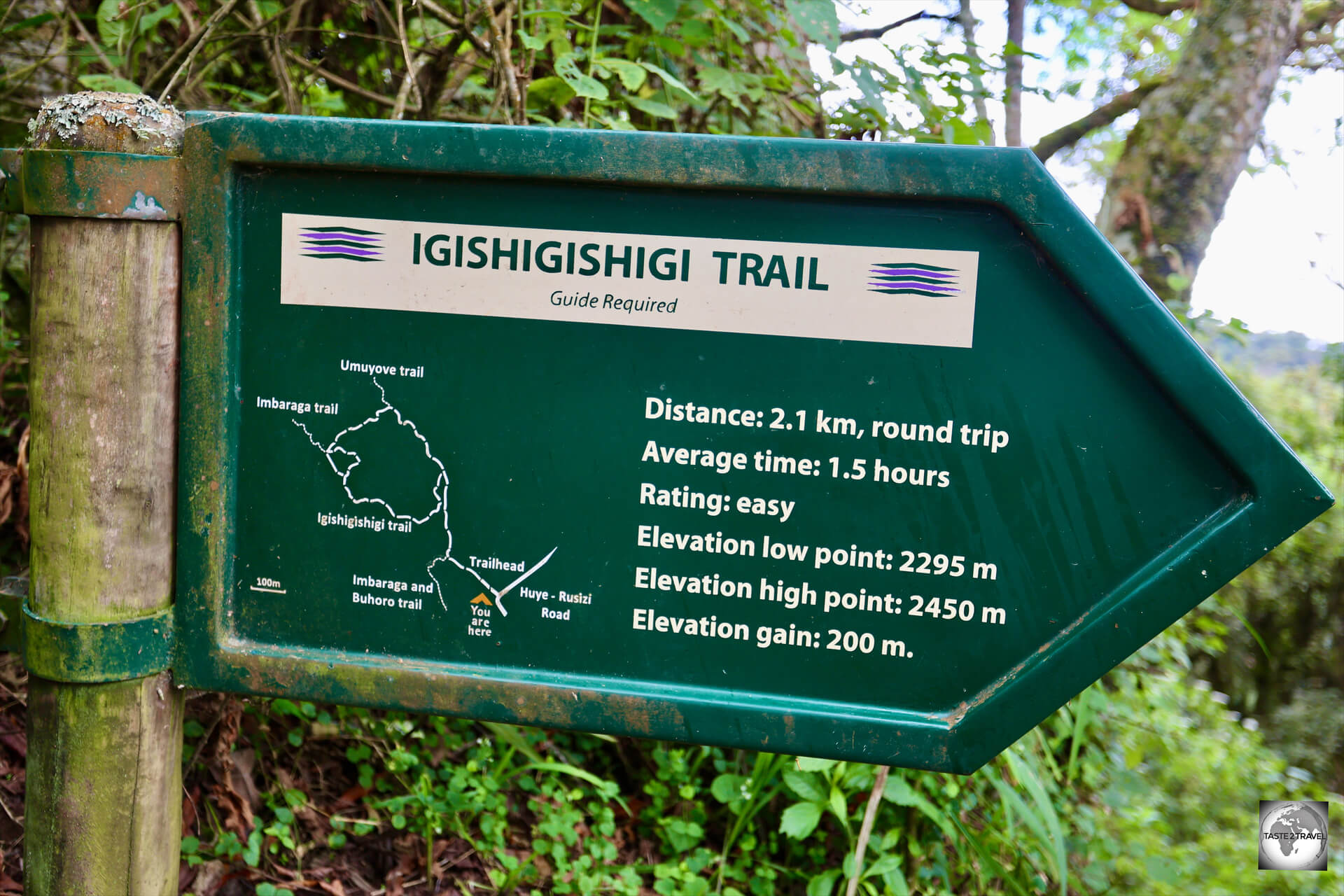
The guided walking trail which leads to the canopy walkway at Nyungwe National Park.
The park includes three communities of chimpanzees which are tracked and monitored daily, and visited by tourists who participate in Chimpanzees Treks which are charged at US$150 for foreign visitors.

Hiking on the walking trail, which leads to the canopy walkway at Nyungwe National Park.
The most popular activity at the park is the hike to the canopy walkway, which is suspended 70-metres above the forest floor.
The fully guided, return trek, from the visitor’s centre takes 2-hours and costs US$40 for foreigners.
For most foreign visitors, who will enter the park and do the Canopy Walkway trek, the total cost will be US$140.

Suspended 70-metres above a ravine in the Nyungwe National Park, the canopy walkway provides an exhilarating perspective on the ancient rainforest.
The canopy walkway, suspended high above the forest floor, provides a unique perspective and thrilling experience as you walk amidst the treetops.

A panoramic view of the rainforest, from the 70-metre-high canopy walkway at Nyungwe National Park.
The canopy walkway was erected by USAID through the Green Heart NGO group in 2010.
The walkway is partitioned in 3 sections; 90 metres, 45 metres and 25 metres, with the 90-metre section being suspended 70-metres above the forest floor.
The canopy walkway at Nyungwe National Park is the third of its kind in Africa and the only one in the East African Region.

A highlight of my visit to Nyungwe National Park was seeing, at close range, the Great blue turaco bird.
The definite highlight of my walk along the Canopy Walkway was being able to get up close to the very shy and elusive Great blue turaco bird.

Who’s a pretty boy? Normally shy and elusive, this Great blue turaco, at Nyungwe National Park, was clearly posing for the camera.
Normally, it’s impossible to get a clear photo of the Great blue turaco since it inhabits the high treetops in the forest canopy.
But since I was up in the canopy, I was able to view, and photograph, this normally elusive bird, on its level.

A front view of a Great blue turaco at Nyungwe National Park.
Despite being widespread throughout Africa, the Great blue turaco is rarely seen from the ground. Being in the canopy provided an excellent opportunity to photograph them.

Nyungwe National Park is home to 13 species of primates, including L’Hoest’s monkey, also known as the Mountain monkey.
The rainforest of Nyungwe National Park is home to over 13 primate species, including chimpanzees, black and white colobus monkeys, blue monkeys, olive baboons and the less-than-shy L’Hoest’s monkey.

Not shy, L’Hoest’s monkey, can be easily seen feeding along the edge of walking trails.
The L’Hoest’s monkey mostly live in mountainous forest areas throughout the Congo basin, in small, female-dominated groups. They have a dark coat and can be distinguished by a characteristic white beard.
The monkey was named in honour of Michel L’Hoest, director of Antwerp Zoo in 1898.
While in the area, I stayed at the excellent Nyungwe Top View Hill Hotel which I would highly recommend. The hotel is located 45-minutes by car from Nyungwe National Park visitor’s centre.
You can learn more about the hotel in the ‘Accommodation‘ section below.
Southern Province
Nyanza (Nyabisindu)

One of the main attractions in Nyanza is the King’s Palace, also known as the Rukari.
Nyanza, also known as Nyabisindu, is a town located in the Southern Province of Rwanda, 90 km (2.5 hours) south of Kigali.
The town holds historical significance as it was once the traditional seat of the Rwandan monarchy and played a central role in the country’s history and culture.
Nyanza was the capital of the Kingdom of Rwanda from 1958 to 1962.
As part of the 1994 genocide, many Tutsis in Nyanza were killed by (Hutu) government forces.
Being the former royal town, with the Tutsi seen as being close to the ruling elites, the Tutsi of Nyanza were especially singled out by the marauding, murderous, Hutu militias.
King’s Palace Museum
One of the main attractions in Nyanza is the King’s Palace Museum, also known as the Rukari.
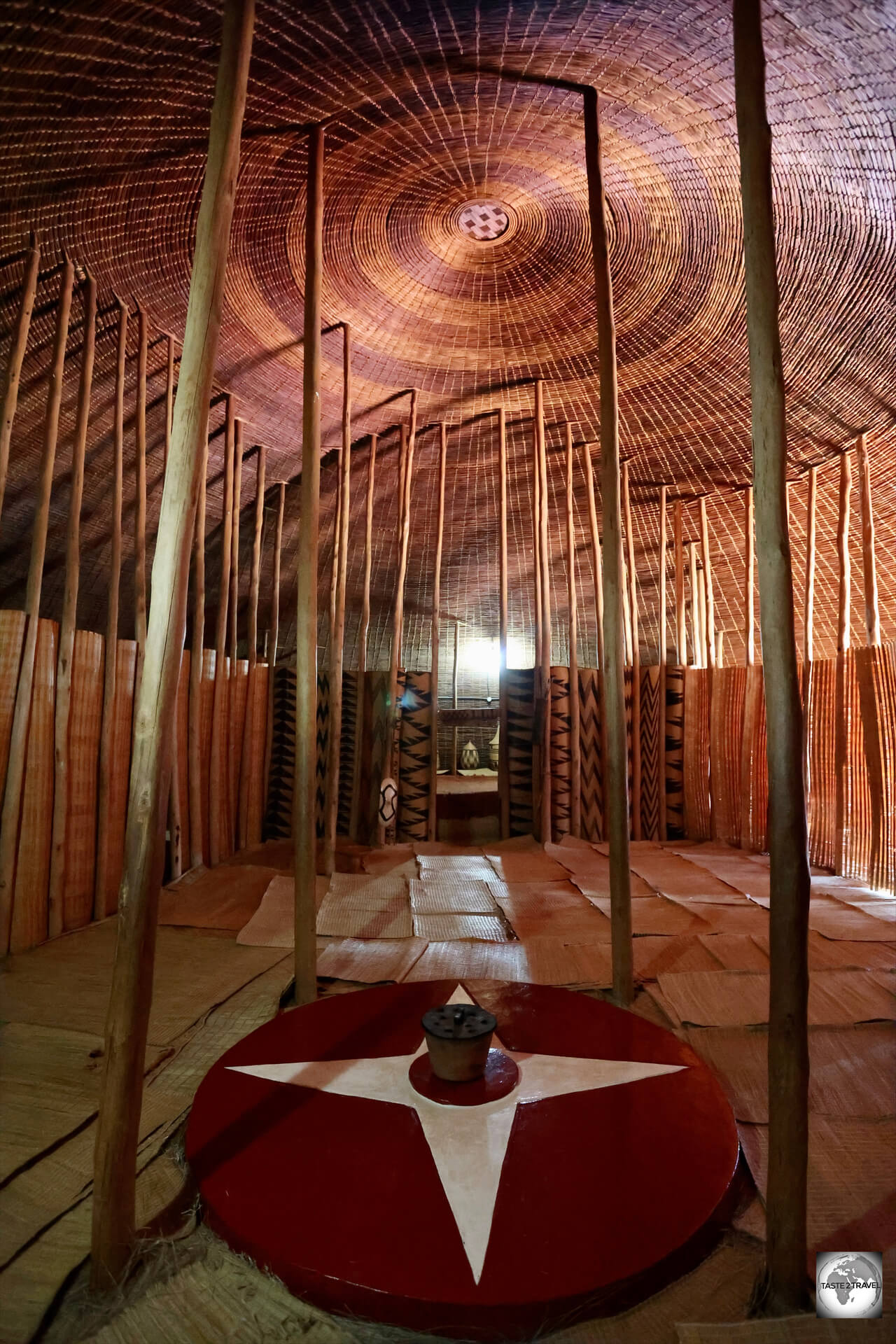
An interior view of the King’s Palace at Nyanza.
This historic site was the residence of the Rwandan kings before the monarchy was abolished.
The monarchy in Rwanda was abolished in 1961 following a referendum where around 80% of voters opposed the continuation of the monarchy, which was seen to be too close to the former colonial rulers.

A view of the intricately woven ceiling of the Royal Palace at Nyanza.
The palace has been converted into a museum that showcases traditional Rwandan artifacts, royal regalia, and exhibits depicting the lifestyle and customs of the Rwandan monarchy.

A herd of long-horned Inyambo cattle are kept at the palace.
At the rear of the palace live a small herd of long-horned Inyambo cattle, which are descended from the king’s herd.
The cattle are cared for by a team of keepers who carefully tend, and sing to them, keeping alive a unique tradition.

The keepers of the Royal Inyambo cattle sing to them.
Considered precious, each of the Inyambo royal cows is given a poem, which is sung to them by their keepers. These poems feature words which reflect the individual characteristics of each cow.
Eastern Rwanda
Akagera National Park

A ‘Zebra Crossing’ in Akagera National Park.
Akagera National Park is a protected area in eastern Rwanda covering 1,122 km2 (433 sq mi) along the international border with Tanzania.
The park was founded in 1934 by the Belgian government, which at the time occupied Rwanda. The park was originally 2,500 km2 (970 sq mi) large and was known for its biodiversity.

A male impala at Akagera National Park.
The park is named for the Akagera River which flows along its eastern boundary feeding into Lake Ihema and several smaller lakes. These lakes are home to crocodiles, hippopotamus and may other animals.

A female impala at Akagera National Park.
The park offers excellent opportunities for game drives, guided walks, and boat safaris along Lake Ihema, where visitors can observe hippos, crocodiles, and water birds.

One of the “Big 5”, the docile and placid looking Cape Buffalo are able to charge at speeds of 50km/h, making them one of the most dangerous animals in Africa.
The scenery and wildlife in Akagera is stunning, a park which is home to the ‘Big 5‘ (following the re-introduction of Rhinos from South Africa) and so much more.

A view across Lake Ihema, towards Tanzania, from Akagera National Park.
Akagera National Park is known for its beautiful savannah landscapes, rolling hills, and scenic lakes.
The complex system of lakes and linking papyrus swamps makes up over a third of the park, which is the largest protected wetland in Eastern-Central Africa.

Boasting the largest protected wetland in Eastern-Central Africa, Akagera National Park is a haven for crocodiles…
Lake Ihema is the largest lake in the park and provides a picturesque backdrop for wildlife viewing.

… and hippopotamus, who like to keep cool in the waters of Lake Ihema.
The park is also dotted with several smaller lakes and swamps, attracting a wide range of wildlife, including crocodiles and hippopotamus.

On the road in Akagera National Park, where I did my own self-drive game safari, in my Toyota RAV4, accompanied by a (compulsory) park guide.
Akagera National Park is one of my favorite game parks in Africa.
I loved that I was able to do my own self-drive game safari in my Toyota RAV4, although I was required to pay for a park guide which is compulsory for all visitors.

An elephant at Akagera National Park.
I spent an entire day driving along dusty tracks, with my Canon R6 (fitted with my long zoom lens) dangling around my neck. Sitting next to me was the park guide, with the two of us keenly spotting wildlife. My guide also acted as my own personal tsetse fly swatter!
Being the driver and photographer, I was able to position the car with the best (photographic) view of each animal, including these friendly elephants.

An elephant at Akagera National Park.
Akagera National Park is managed by African Parks, a non-governmental NGO based in Johannesburg, South Africa. This is the same organisation that manages Nyungwe National Park, with similarly high fees being charged for foreign visitors.
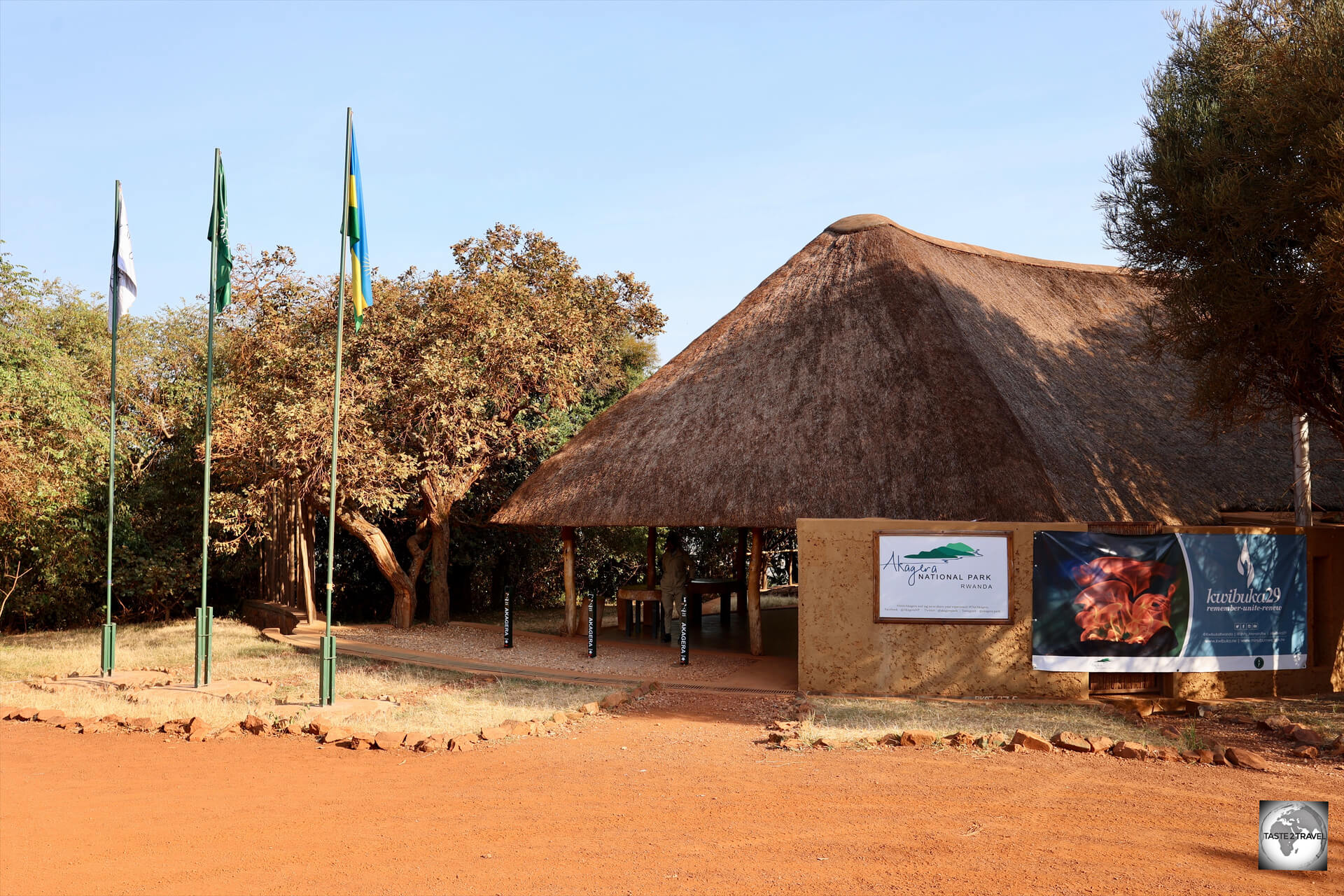
The visitor’s centre at Akagera National Park.
Entrance to the park costs US$100, per day, for foreign visitors, while Rwandans are charged 15,000 RWF (US$12.45).
A vehicle entry fee is also charged in addition,
You are not permitted to drive by yourself in the park. All vehicles must carry a park guide, with fees being set at US$25 (half day) or US$40 (full day).

Akagera National Park is home to large herds of the common Plains zebra.
Did you know?
There are the three living species: the Grevy’s zebra, Plains zebra, and the Mountain zebra.
Akagera National Park is home to around 1,000 of the more common Plains zebra.

A fine example of a Topi, an African antelope, at Akagera National Park.
Akagera is also home to around 500 Topi, which is a lean and fit, highly social, fast type of antelope found in the savannas, semi-deserts, and floodplains of sub-Saharan Africa.

Akagera National Park is home to more than 85 Rothschild giraffes.
The first giraffes in Akagera National Park were introduced from Kenya in 1988. The latest aerial survey found an estimated 100 giraffes inside the park.

A Rothschild giraffe at Akagera National Park.
Do you know how giraffes sleep?

A juvenile Rothchild’s giraffe sleeping on the ground.
Due to their awkward bodies, adult giraffes cannot simply lay down to sleep but rather sleep standing up and with one eye open.
They also tend to power nap, grabbing 5-minutes sleep here and there.
All of this ensures that should they come under attack by a predator, they can defend themselves, and escape, much more easily than if they were lying on the ground sleeping and had to first stand up – which takes a giraffe a moment or two.

A juvenile Rothchild’s giraffe sleeping on the ground, while guarded by both parents.
Juvenile giraffes often sleep on the ground but with their head upright and one eye open.
They are normally guarded on either side by both (standing) parents as can be seen in the above photo which was taken at Akagera National Park.

There are many cheeky Olive baboons at Akagera National Park.
Also resident in Akagera National Park are large troops of Olive baboon, which has the distinction of being the most wide-ranging of all baboons, being native to 25 countries throughout Africa, extending from Mali eastward to Ethiopia and Tanzania.
The common name is derived from its coat colour, which is a shade of green-grey at a distance. A variety of communications, vocal and non-vocal, facilitate a complex social structure.

Akagera National Park is home to herds of the very large Cape Buffalo.
A sub-species of the African buffalo, the Cape buffalo, is the largest species of buffalo found in Southern and East Africa. They can be found grazing in herds throughout Akagera National Park.
The adult African buffalo’s horns are its characteristic feature: they have fused bases, forming a continuous bone shield across the top of the head referred to as a “boss”.
While a placid and docile herbivore, its unpredictable temperament may be part of the reason why the African buffalo has never been domesticated, unlike its Asian cousin!
Able to charge, without warning, at speeds of 50km/h, the buffalo is considered to be one of the most dangerous animals in Africa.

The African fish eagle is a common sight in Akagera National Park.
Akagera National Park hosts a huge variety of birdlife, with the African fish eagle sitting at the top of the chain.
As its name would suggest, this species of eagle specialises in hunting fish, so the huge wetland at Akagera National Park is the ideal hunting ground for this bird.
Black-headed weaver birds

Black-headed weaver birds are named due to their extraordinary weaving skills, which they use to construct intricately woven nests.
At the opposite end of the food chain to the predatory African fish eagle, is the cute, but highly talented, Black-headed weaver bird.

Weaver bird nests are always constructed by males, in the hope of attracting a mating partner.
Weaver birds are named for their elaborately woven nests, which are characterised by narrow, downward facing, entrances.
The Black-headed weaver bird lives in large, social colonies, close to lakes and wetlands, which makes Akagera National Park an ideal location for this species. They typically build their nests in close proximity to each other in tall acacia trees.

Inspection time: a female Weaver bird, inspecting a nest.
Weaver bird nests are always constructed by males, in the hope of attracting a mating partner.
The nests vary in size, shape, material used, and construction techniques from species to species. Materials used for building nests include fine leaf fibers, grass, and twigs.

This tree full of nests is located beside a café in Akagera National Park.
The Weaver birds at Akagera National Park are gregarious and breed colonially, with hundreds of nests located in a single tree.
The birds build their nests together for protection, often several to a branch.
Usually, the male birds weave the nests and use them as a form of display to lure prospective females.
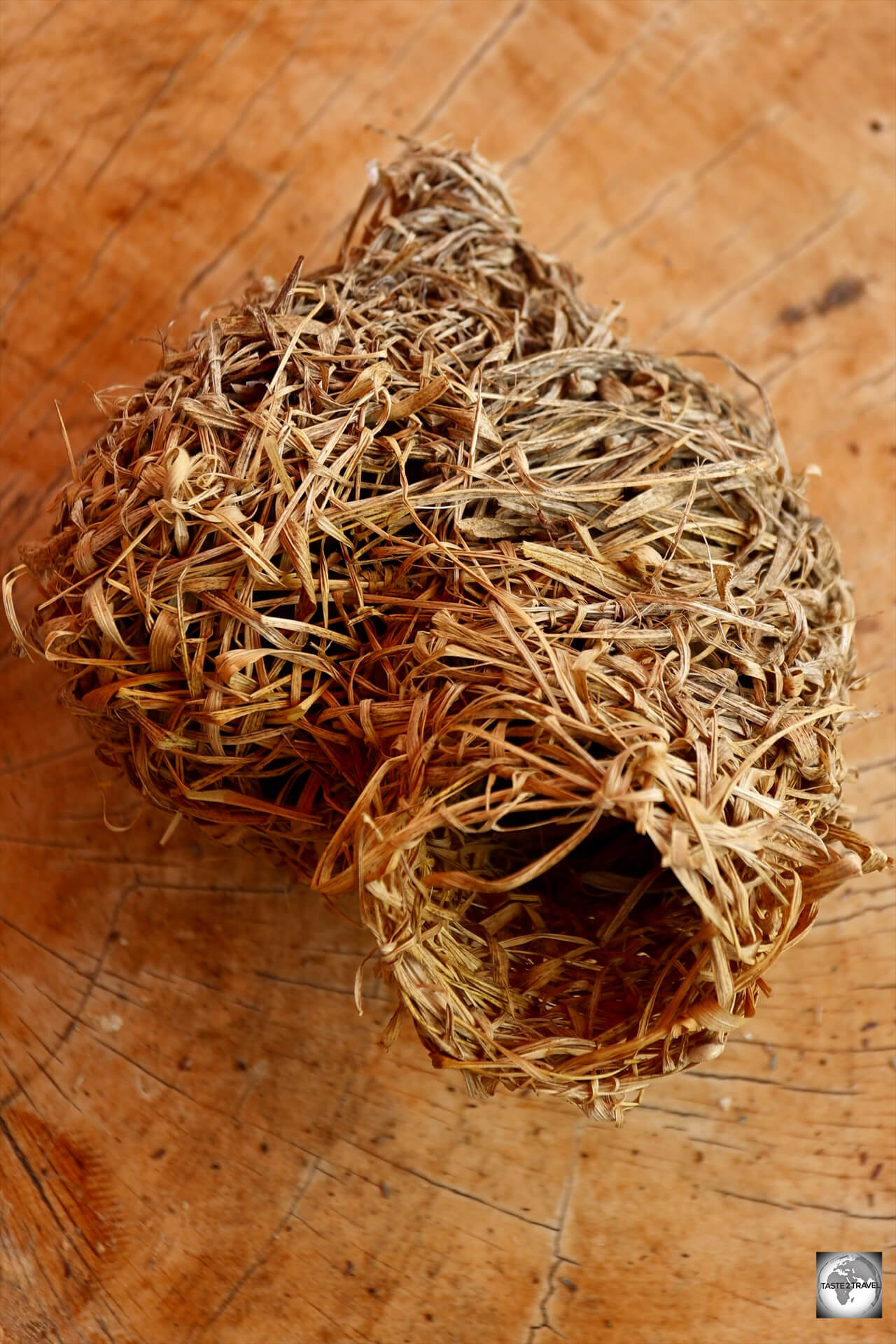
A fallen weaver bird nest – a masterpiece of weaving which they accomplish using only their beaks.
The Dreaded Tsetse flies of Akagera National Park

A warthog, which is actually under siege, in Akagera National Park.
Tsetse are large, biting flies that inhabit much of tropical Africa, and are especially prolific in Akagera National Park.
Like Horse flies in other parts of the world, Tsetse flies are a parasite, which lives by feeding on the blood of vertebrate animals.

Biting Tsetse flies can be clearly seen on the snout of this warthog in Akagera National Park.
While you travel around Akagera National Park, you will be constantly under attack from these ravenous, incessant, insects.
While I was driving my car around the park, swarms of Tsetse flies would enter the car, delivering nasty bites to both me and my guide.
Despite being fully covered, the Tsetse fly would simply bite through my clothing.
Really nasty insects – even worse than mosquitoes!

A juvenile, female, Waterbuck at Akagera National Park.
Accommodation
As can be expected from a country which prioritises tourism, Rwanda offers a range of accommodation options to suit different budgets, preferences, and travel styles.
Whether you’re looking for luxury hotels, boutique lodges, budget-friendly guesthouses, or immersive eco-lodges, Rwanda has something to cater to your needs.
Wherever I stayed in Rwanda, the standard of accommodation, and level of service, was excellent! Hotel staff in Rwanda are trained in hospitality schools and it shows.
Kigali City

Rooms at the Court Boutique Hotel in Kigali are modern, clean, spacious and very comfortable.
While in Kigali, I stayed at two excellent accommodation options – the Court Boutique Hotel, and the iconic, and infamous, Hotel Des Mille Collines, aka Hotel Rwanda.
Court Boutique Hotel

A standard room at the Court Boutique Hotel in Kigali.
My home-away-from-home while in Rwanda was the wonderful Court Boutique Hotel which offers a selection of rooms, with standard rooms starting at US$120 per night.
Heavily discounted rooms can sometimes be found on booking.com

The suite at the Court Boutique Hotel offers a spacious living room and a balcony with views over Kigali.
During my three weeks in Rwanda, I stayed at the Court Boutique Hotel whenever I returned back to Kigali. I experienced all of their room types from ‘standard’ to their deluxe ‘suite’.
All rooms are beautifully designed, spacious and very comfortable. A buffet breakfast is included in the room rates.

A view of suburban Kigali, from the balcony of my suite at the Court Boutique Hotel.
From the professional and helpful staff, the quiet, suburban setting, the well-maintained gardens, which attract lots of bird life, and the inviting rooms, the Court Boutique Hotel was somewhere I was always happy to return to.
Highly Recommended!

Another of my many rooms at the Court Boutique Hotel in Kigali. My home-away-from-home in Rwanda.
Hotel des Mille Collines

The historic Hotel des Mille Collines was the inspiration for the Hollywood hit movie ‘Hotel Rwanda’.
The Hotel des Mille Collines (English: Hotel of the Thousand Hills) is a large hotel in downtown Kigali. The hotel offers 4-star accommodation in 112 rooms, which are dated but comfortable.

Staying in a piece of history, my room at the 4-star ‘Hotel des Mille Collines’, dated but comfortable.
The hotel also offers a bar, a café, three conference rooms, a restaurant, a swimming pool, and tennis courts.

The former Sabena office at the Hotel des Mille Collines is now occupied by its successor, Brussels Airlines.
The Belgian airline Sabena built the hotel in 1973 and owned it during the Rwandan Genocide. The now-defunct Sabena sold the hotel in 2005, although its successor, Brussels Airlines now occupies the former Sabena office.

The events, which took place at the Hotel des Mille Collines during the genocide, formed the inspiration for the movie “Hotel Rwanda”.
The hotel became famous after 1,268 people took refuge inside the building during the Rwandan genocide of 1994.
The story of the hotel, and its manager at that time, Paul Rusesabagina, was later used as the basis of Terry George’s film Hotel Rwanda in 2004.

A memorial, to hotel staff members who died during the 1994 Genocide, at the Hotel des Mille Collines.
A memorial, in the front garden of the hotel, is dedicated to seven hotel staff members who died during the 1994 Rwandan genocide.

The lobby of the Hotel des Mille Collines.
While rooms at the hotel are old and faded, the swimming pool, restaurants and other facilities are as can be expected of a 4-star hotel. It is a fine stay, located in the heart of Kigali.
For me, a stay at the Hotel des Mille Collines was an essential part of my trip to Rwanda, simply because of the historical aspect of the hotel.
Northern Province
Lake Ruhondo

A view of my cottage at ‘My Hill Eco Resort’, which is located at the end of a peninsula on Lake Ruhondo.
While visiting scenic Lake Ruhondo, I stayed at the very remote (click for Google Map view), but beautifully located, ‘My Hill Eco Resort‘.

A view of Lake Ruhondo from ‘My Hill Eco Resort’.
The resort is located at the end of a long peninsula which is accessed via either a very rough, long, windy, gravel track or by a short boat ride from the opposite shore of the lake.

‘My Hill Eco Resort’ offers basic accommodation.
Although I drove my RAV4 all the way to the resort, I would not do the drive again and I would not recommend the drive. The gravel road is car destroying and suitable only for high-clearance 4WD vehicles. The track is normally used by locals riding motorbikes, rather than by cars.
By far, the easiest way to reach the resort is by boat, which leaves from a pier on the opposite side of the lake, a short drive from the provincial capital, Ruhengeri. Take the boat!

A view of Lake Ruhondo, and the, cloud-covered, Virunga Mountains, from “My Hill Eco Resort”.
The resort offers accommodation in basic bungalows, or in tented ‘glamping’ shelters.
All rooms are built on the slopes of a hill which overlooks the lake. This ensures each room offers panoramic views of the lake and the distant mountains – including the volcanic Virunga Mountains, the home of the Mountain gorillas.
Ruhengeri

My room at the Indani Residence in Ruhengeri.
After visiting Lake Ruhondo, I relocated into the provincial capital of Musanze (formerly ‘Ruhengeri‘) where I stayed at the very cosy and excellent Indani Residence.

The beautifully designed living room at the Indani Residence in Ruhengeri.
The Indani Residence (click for Google Map view) is a small, family-run, guest house which is located in a quiet suburban street of Ruhengeri.
My room, which was comfortable and spacious, offered a view of the tranquil back garden.
Also included was a substantial breakfast.
Western Province
Rubavu (formerly known as Gisenyi)

My totally underwhelming room at the Musanto Hotel in Gisenyi.
While in Gisenyi, I stayed at the very average Musanto Hotel where rooms cost around US$30 per night.
The hotel, which is located one block back from Lake Kivu, has little to recommend it!
Although a very uninspiring breakfast was included, I chose to instead pay for a much better breakfast at the nearby Migano Café.
Lake Kivu Serena Hotel
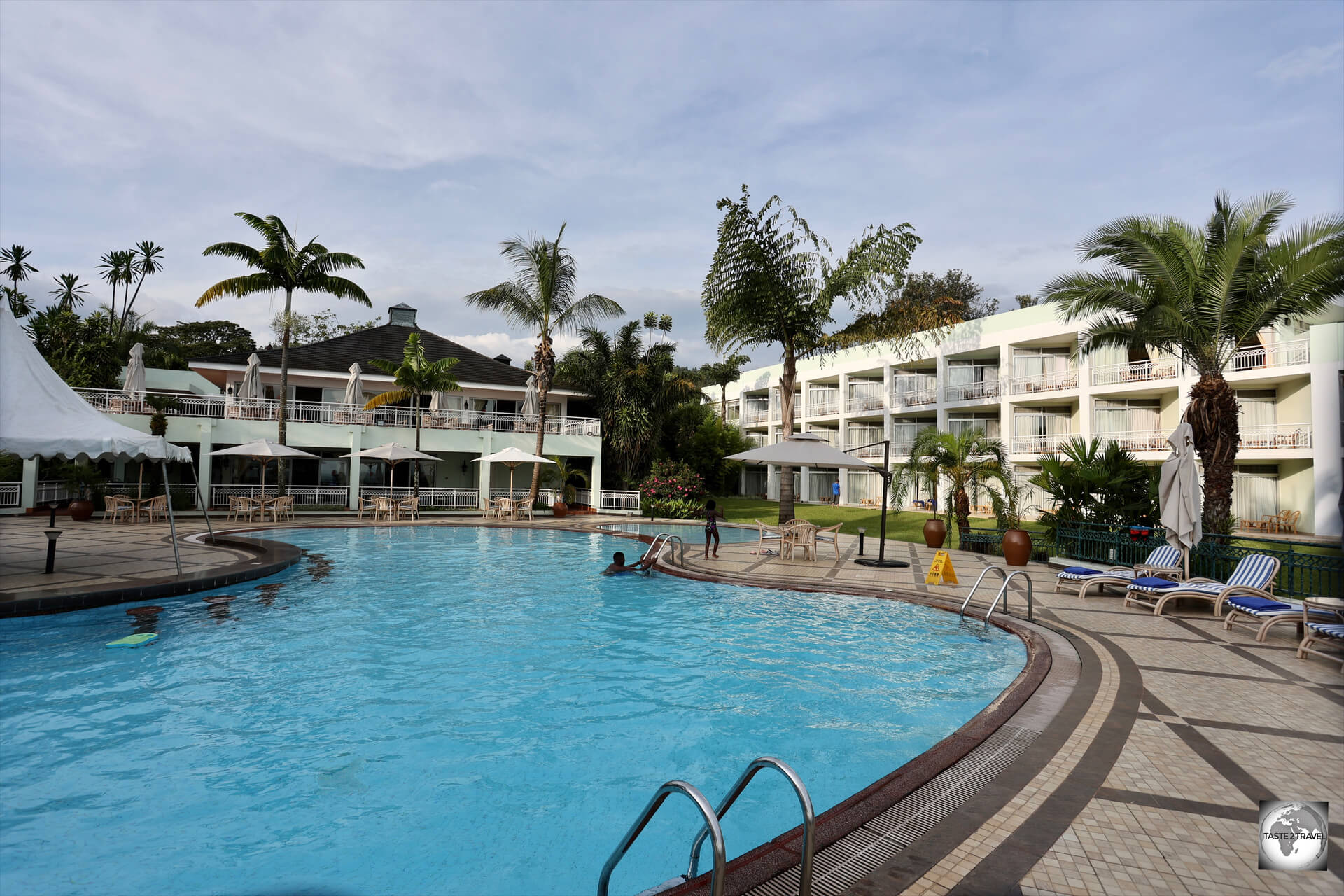
The swimming pool at the Lake Kivu Serena Hotel in Gisenyi.
While I didn’t stay there, I enjoyed spending time, poolside, at the Lake Kivu Serena Hotel in Gisenyi.
This is the best option in Gisenyi, with standard rooms starting at around US$170 on booking.com
The hotel is situated directly on the beach at Lake Kivu.
Kibuye (Karongi)
While there are many accommodation options in the Lake Kivu town of Kibuye, Moriah Hill Resort offers excellent rooms and one of the best restaurants in town, from its scenic perch, overlooking Lake Kivu.
With standard rooms priced from US$120 per night, this family-run hotel is located at the end of its own peninsula.
I especially recommend the locally caught fish, which is served in their signature fish ‘n’ chips, which is served in the restaurant.
Nyungwe National Park

Located a short drive from Nyungwe National Park, the Nyungwe Top View Hill Hotel is perched on top of a mountain which offers panoramic views of the rainforest and Lake Kivu.
In a country which offered so many wonderful accommodation options, my stay at the Nyungwe Top View Hill Hotel ranked as possibly my favourite stay.

The striking design of the lobby of the Nyungwe Top View Hill Hotel.
Set on top of a hill within the Nyungwe Forest National Park, Nyungwe Top View Hill Hotel boasts panoramic views of the surrounding mountains.
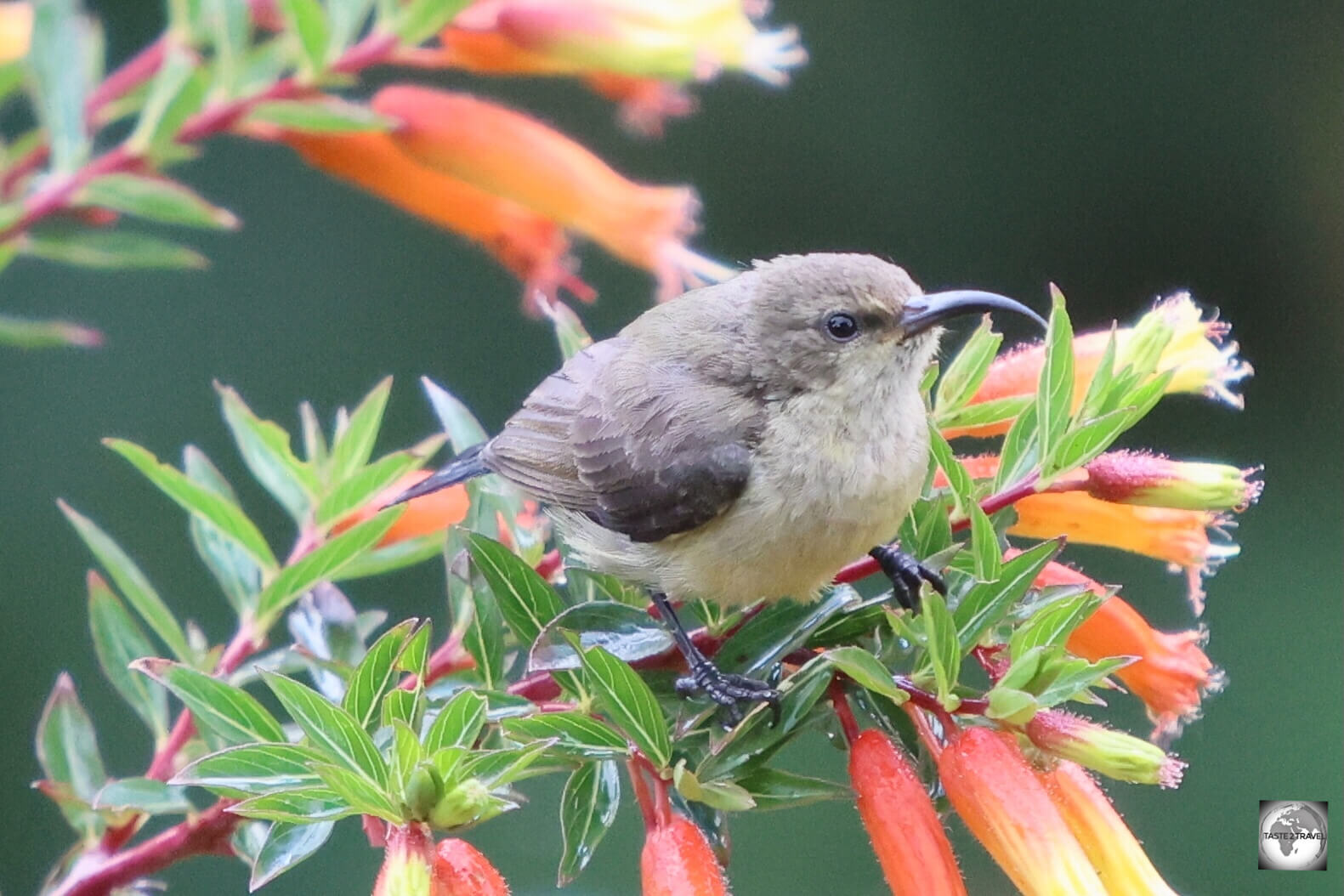
A female Northern double-collared sunbird, which I photographed in the garden at Nyungwe Top View Hill Hotel.
From Lake Kivu, to the sprawling local tea plantations, to the Nyungwe Forest National Park, the entire world is visible from the hilltop location of the Nyungwe Top View Hill Hotel.
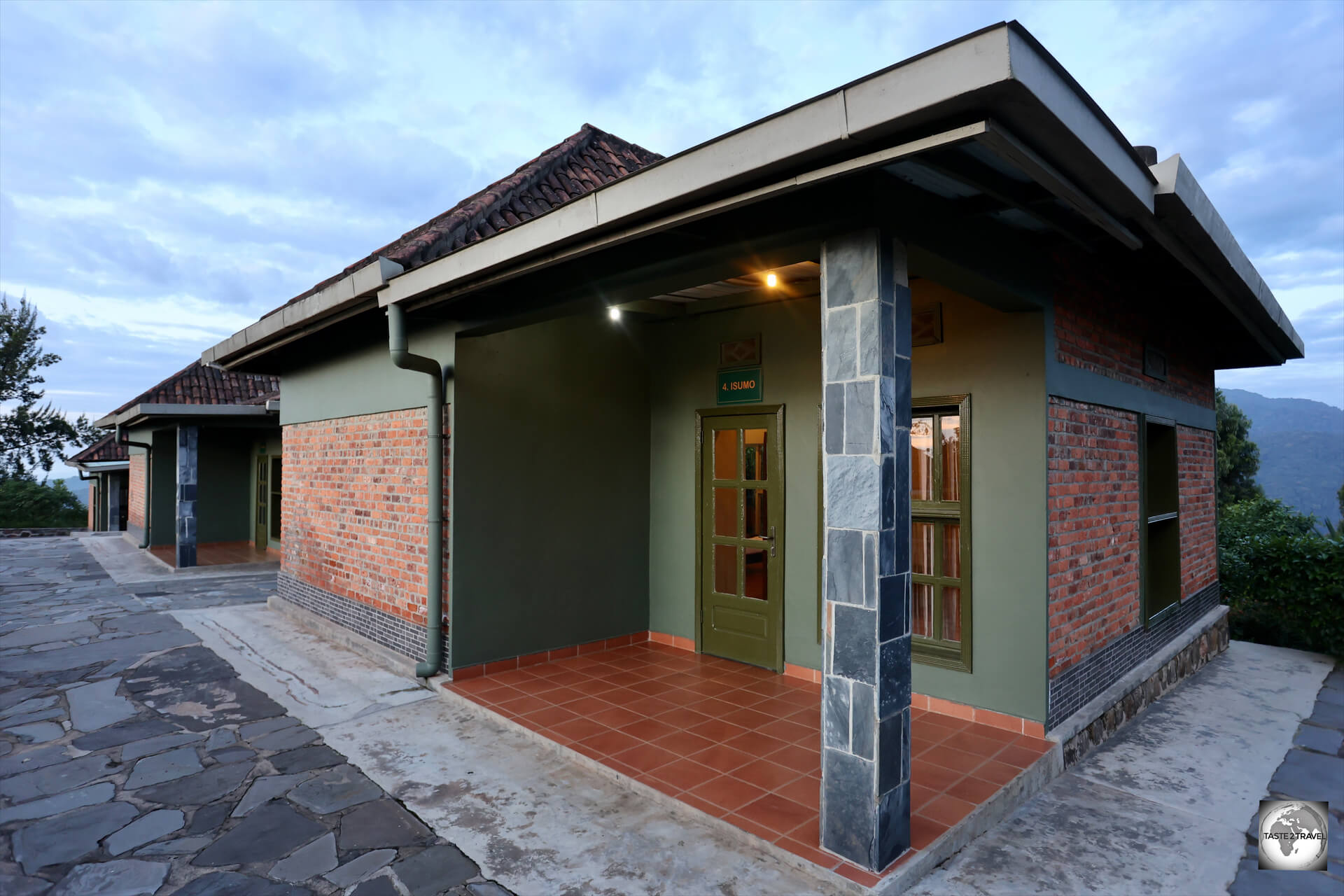
Rooms at the Nyungwe Top View Hill Hotel are in self-contained bungalows.
The hotel offers a collection of 12 individual bungalows (the size of a small home), with six of them offering views of the western side of the park, while the other six face the eastern side.

The more colourful (male) Northern double-collared sunbird, which I photographed in the garden at Nyungwe Top View Hill Hotel.
Thanks to an unbeatable promotional rate, I extended my stay and could have easily stayed longer.

The gardens at Nyungwe Top View Hill Hotel attract Vervet monkeys.
Rooms on booking.com are often discounted to US$140. This is a treat but totally worth it!

My very spacious and comfortable room at the Nyungwe Top View Hill Hotel.
The bungalows feature a spacious room, king-sized bed with a nightly turn-down service. This included hot water bottles being placed under the sheets, which were welcome during the chilly evenings.

A vervet monkey, in the garden at Nyungwe Top View Hill Hotel.
Each bungalow has a large balcony which offers views over the surrounding countryside.

The view of the rainforest, from my balcony at the Nyungwe Top View Hill Hotel.
The gardens are full of colourful birds which make for interesting photography.

The sitting room, which was attached to my room at the Nyungwe Top View Hill Hotel.
Also included in the bungalow is a spacious sitting area, with a fire place, and a very spacious bathroom.

The view from my breakfast table, in the restaurant, at the Nyungwe Top View Hill Hotel.
Dinner and breakfast each day was served in the restaurant which offers the most amazing views of the entire property and the surrounding countryside.
Highly Recommended!
Eastern Province

While visiting Akagera National Park, I stayed at the wonderful Rutete Eco Lodge.
While visiting Akagera National Park, I stayed at the highly recommended Rutete Eco Lodge.
The brainchild of the wonderfully positive and enthusiastic Julienne – a Belgium/ Rwandan entrepreneur with a clear vision, Rutete Eco Lodge is no ordinary accommodation and even has its own philosophy which is focused on sustainability, the reduction of poverty, community involvement, environmental conservation and more.
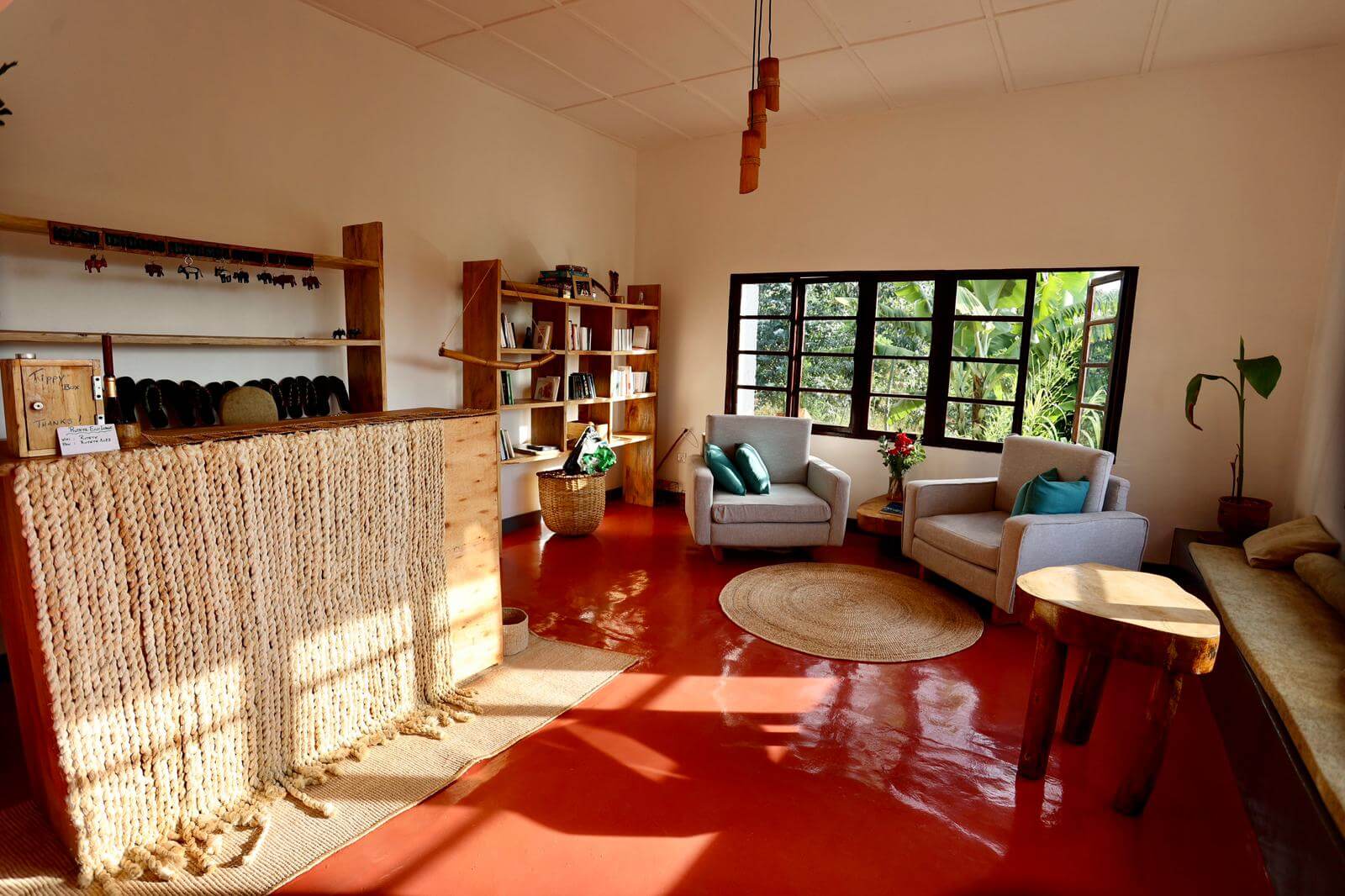
All the decorations and furniture at Rutete Eco Resort were handmade by local villagers.
The original colonial house, which is the centre-piece of the property, was built by Julienne’s (Belgium) father who worked, during the colonial years, for a Belgium mining company.

The beautifully designed interiors of the Rutete Eco Lodge, including the upholstered chairs, were handmade, from locally sourced materials, by local villagers.
Her father was relocated from a mine in the Democratic Republic of Congo (DRC) to the remote town of Rwinkwavu, in the Eastern Province of Rwanda, to supervise a new mine site.
At the time, there was no suitable accommodation for the family in Rwinkwavu, so Julienne’s father worked with local villagers to build the present colonial house.
The name ‘Rutete‘ comes from the local language and means ‘basket’. An example of one of these woven baskets can be seen in the photo above, sitting on the mantle.
Apparently, local villagers referred to Julienne’s father as ‘Rutete’ as he had a kind habit of delivering food to local villagers using such woven baskets.

The beautifully renovated colonial house is the centre-piece of Rutete Eco Resort.
During the 1994 genocide, the family fled to the safety of Belgium. During the genocide, the house was taken over by the military who used it as a base.
Video: Living out an “Out of Africa” fantasy during a tour of Rutete Eco Resort.
Following the genocide, the military vacated the house, at which point squatters took over.
Many years later, Julienne, backed by some fellow investors, decided to reclaim the family property and convert the sprawling property into an eco-resort.
Before she could do this, she needed to have property documents issued by the Rwandan government – a protracted process which took 10 years to complete.

A view of a garden bungalow at Rutete Eco Resort.
Once the documents had been issued, Julienne wasted no time in renovated the derelict property, and converting it into the shiny, new, dazzlingly-designed, eco resort that guests can experience today.

One of the garden bungalows at Rutete Eco Resort.
As part of her deeply-ingrained community spirit, Julienne recruited local villagers and crafts people to do all of the renovations, build all of the furniture, including the upholstered chairs you can see in the photos here, weave all of the mats and wall hangings and much more.
There is a whole lot of love for Rutete Eco Resort, a venture which involves the entire local community.
During my stay, Julienne told me that she is building a gift shop at the front of the property, on the main road, which she will make available to local women who can use the space to sell their handicrafts.

A highlight of Rwanda, Akagera National Park is a 10-minute drive from Rutete Eco Resort.
Rutete Eco Resort is an inspiring, and still evolving, story.
I highly recommend anyone visiting Akagera National Park to consider staying at this resort, which is a 10-minute drive from the national park.

Truly divine – poached eggs and locally sourced avocado for breakfast at Rutete Eco Resort.
One highlight of the resort are the exquisite meals, which are prepared using fresh produce from the garden.
There are almost no dining options in the local area so it makes sense to dine at the resort. Dinner each evening consisted of a 3-course meal which ended with homemade ice cream, topped with wild raspberries from the garden,

The most amazing meals were served at the large handmade dining table at the Rutete Eco Resort.
All meals are served at the huge wooden dining table which was carved out of one large, fallen tree, which was found on the property.
Rooms include garden bungalows and a deluxe room inside the main bungalow.
Eating Out
Cuisine
Rwandan cuisine is a reflection of the country’s cultural diversity and agricultural abundance. It incorporates locally sourced ingredients, traditional cooking methods, and influences from neighbouring countries. The cuisine of Rwanda is generally simple, hearty, and focused on staple foods.
Akabanga

Akabanga is a popular chili oil condiment in Rwanda.
Akabanga is a popular Rwandan condiment made from chili peppers and vegetable oil. It is a spicy sauce used to add heat and flavor to various dishes.
It can be found on every restaurant table across the country, and is always applied to most meals by locals.
Tea and Coffee

The hilly terrain of Rwanda produces excellent Arabica coffee beans. The hilly terrain of Rwanda produces excellent Arabica coffee beans.
Rwanda is known for its high-quality tea and coffee production.
Rwandan tea, served hot or iced, is a common beverage enjoyed throughout the day. Rwandan coffee is also highly regarded, with a rich flavor profile.
Restaurants and Cafes
Kigali City

Caffe Latte and a pastry at Bourbon Coffee. in Kigali.
While in Kigali, I made a daily pilgrimage to one of the branches of Bourbon Coffee.
With several branches throughout town, including at the airport, Bourbon Coffee serves the most amazing, locally grown, Arabica coffee along with fresh pastries, sandwiches, burgers and more.
There are plenty of positive reviews on TripAdvisor for this successful, local café chain.
Highly Recommended!
Northern Province
Lake Rohondo

Stunning views of Lake Ruhondo from the restaurant at ‘My Hill Eco Resort’, the only dining option in this part of Rwanda.
If you are visiting Lake Ruhondo, one of the few restaurants is to be found is at the very remote ‘My Hill Eco Resort‘.
The restaurant serves meals of fresh lake fish, chips and salad!
Divine!
Musanze (Ruhengeri)

Offering excellent coffee and tasty food, the very popular Crema café is the best café in Ruhengeri.
Located in the heart of Ruhengeri, Crema Café is the most popular café in town, garnering lots of favourable reviews on TripAdvisor.
I visited on several occasions and can attest to the popularity of this café. It seems most tourists in town visit this café at lunchtime.
Western Province
Rubavu (Gisenyi)
The best restaurant/ café option in Gisenyi is the very popular Migano Café which is located one block back from Lake Kivu, close to the Lake Kivu Serena Hotel.
There is also a branch of Migano Café in the town of Ruhengeri.
Visa Requirements
Visa Policy

The wonderfully simple visa policy of Rwanda is possibly the friendliest of all African visa polices.
On many fronts, the government of Rwanda has proven itself to be the most visionary of all African governments.
Rwanda chooses to lead by example with its focus on promoting sound economic growth, which has led to a substantial increase in the standard of living of most Rwandans.
It’s simple ‘Economics 101‘ but most, self-serving, African governments fail to deliver for their citizens, due to rampant corruption.
An important part of Rwanda’s economic growth strategy has been the development of tourism, which, as of 2019, contributed to 15.1% of the country’s GDP. A not-too-shabby result!
In order to promote tourism, the government of Rwanda has realised that a simplified Visa Policy helps to increase visitor arrivals and hence promote tourism.
It’s baffling that most other African governments have yet to realise this. Instead, they typically punish visitors by imposing hefty visa fees, onerous requirements, or simply choosing to decline visa applications.
Most importantly for African passport holders, Rwanda provides either visa free entry, or visa-on-arrival for all Africans! According to the Africa Visa Openness index, Rwanda is ranked 5th in Africa for its ‘visa openness’ for other African nationalities.
During his Chairmanship of the African Union (AU) in 2018, Rwandan President, Paul Kagame pledged to make travel in Africa, visa free for all Africans.
However, this vision met resistance from many, entrenched, African leaders and, as a result, most Africans still require visas to travel to most other African countries, proving that, once again, the African Union is an ineffective organisation and the name of the organisation is actually a huge contradiction. There is little ‘union‘ among African nations.

My Rwandan entry and exit stamps.
Immigration Procedure
On arrival at Kigali International Airport, the stamping of my Australian passport took about one minute.
While passport holders of neighbouring countries are granted a stay of 6-months, many other nationalities are granted a stay of 90-days.
Australians, and most non-African nationalities are granted a stay of 30-days.
With such a relaxed visa policy, the Rwandan government is demonstrating its desire to encourage tourism to the country. A refreshing change for an African country and an example for the rest of the continent!
Getting There

RwandAir is the national airline of Rwanda.
You can enter landlocked Rwanda either by Air, at Kigali International Airport, or at a number of land borders.
Air

Kigali International Airport is a clean, modern, efficient airport. A rare gem in Africa!
The most convenient way to travel to Rwanda from international destinations is by air.
International flights to Rwanda arrive at the modern, clean and orderly Kigali International Airport (IATA: KGL) which is located a short drive from downtown Kigali.
Unlike arrival procedures at many other African airports, Kigali airport offers a relaxed, efficient, and fast entry process.

My boarding pass, for my RwandAir flight from Kigali to Dubai.
From the time I disembarked the plane, until I exited the terminal, typically took less than 20-minutes.
Unlike some airports in Africa, there is no corruption at Kigali airport and staff are polite, respectful, friendly and welcoming.
A refreshing change!

Flight departures from Kigali International Airport.
The airport serves as a hub for the national carrier – RwandAir.
The following airlines operate scheduled services to/from Kigali International Airport:
- Auric Air – flies to/ from Entebbe, Grumeti, Mwanza, Seronera
- Brussels Airlines – flies to/ from Brussels
- Coastal Aviation – flies to/ from Mwanza
- Egyptair – flies to/ from Cairo
- Ethiopian Airlines – flies to/ from Addis Ababa
- Kenya Airways – flies to/ from Nairobi–Jomo Kenyatta
- KLM – flies to/ from Amsterdam
- RwandAir – flies to/ from Abidjan, Abuja, Accra, Addis Ababa, Bangui, Brazzaville, Brussels, Bujumbura, Cape Town, Cotonou, Cyangugu, Dar es Salaam, Doha, Douala, Dubai–International, Entebbe, Goma, Harare, Johannesburg–O.R. Tambo, Juba, Kilimanjaro, Kinshasa–N’djili, Lagos, Libreville, London–Heathrow, Lubumbashi, Lusaka, Mombasa, Mumbai, Nairobi–Jomo Kenyatta, Paris–Charles de Gaulle
- Turkish Airlines – flies to/ from Istanbul
Airport Transport
Taxis are available outside the arrival’s hall.
The official metre rates are, from the airport, RWF 2,500 for the first kilometre traveled and 600 RWF per additional kilometre. A typical fare to most downtown locations would be RWF 3,500 – 4,000.
Most hotels offer an airport shuttle service which typically costs USD$20 – 30.
Land
Rwanda, a landlocked country, shares land borders with the following neighbouring countries:
Uganda (North): Rwanda’s northern border is primarily defined by Lake Victoria, one of Africa’s largest lakes. The border with Uganda runs along the northern shores of Lake Victoria and is characterised by hilly and sometimes rugged terrain.
Tanzania (East): Rwanda’s eastern border is with Tanzania, and it stretches through the scenic mountainous areas of the Eastern Province of Rwanda. A large section of the border falls within the boundaries of the wonderful Akagera National Park.
Burundi (South): To the south, Rwanda shares a border with Burundi. This border is marked by hilly terrain and valleys, similar to much of Rwanda’s landscape. The Akagera River forms part of the southern border between the two countries.
Democratic Republic of the Congo (West): Rwanda’s western border is with the Democratic Republic of the Congo (DRC). The border in this region is characterised by a mix of mountains, lakes and forests. The spectacular Lake Kivu forms a large part of the border between Rwanda and DRC.
Getting Around

I explored all of Rwanda on a long, meandering journey in my Toyota RAV4 rental car.
Traveling around Rwanda can be an enjoyable and relatively straightforward experience. I elected to rent a car and drive myself around the country, which was very relaxed and easy. Rwanda is a perfect country for self-drive road trips.
Most tourists I met were using the services of a local tour company. A very popular option, which allows you to relax and let someone else do the driving and guiding, although at a much higher daily cost!
Public Transport
Buses are the most common form of public transport in Kigali and throughout Rwanda.
Buses in Rwanda are generally modern and comfortable, and operate on set schedules and routes. Destinations and routes are marked by the colours of the buses and a destination board at the front of the bus.
Bus stations in Kigali are known as ‘taxi parks,’ and you’ll usually find one in every neighbourhood. Additionally, modern bus stops, equipped with a shelter and a seat, can be found along the main roads of Kigali and in the countryside.
Tap & Go Cards
To board a bus, you’ll need a Tap & Go card. These cards are available in every taxi park and most bus stops.
Taxis
If you plan to use taxis in Kigali, its best to install the YEGO ride hailing app.
For YEGO taxis, you can also call 9191, a toll-free number, to order your ride.
Motorbike Taxis
Motorbike taxis, known as ‘motos’ in Rwanda, are the most popular form of public transport in Kigali.
Moto drivers, who can be easily identified by their distinctive yellow vests, usually work from ‘stations’ – i.e. junctions and roadside areas where they wait for passengers. All moto drivers carry an extra helmet for their passengers.
Moto drivers in Kigali work on fixed fares based on distance. Fares between most parts of Kigali typically cost from RWF 500-2,000, although foreigners can be sometimes overcharged – but not by much.
Fares should be negotiated before you commence your journey.
Domestic Flights
If you’re looking to cover longer distances quickly, domestic flights are available between Kigali and other major cities like Butare, Gisenyi, and Akagera.
RwandAir is the national carrier that operates domestic flights within the country.
Rental Car

Exploring Rwanda on your own self-drive holiday is totally feasible.
Renting a car, or hiring a driver with a vehicle, is a convenient option for traveling around Rwanda.

While in Rwanda, I rented a Toyota RAV4 through Kigali Car Rentals.
I rented a car through Frank, the helpful owner of Kigali Car Rentals, who offered me an older Toyota RAV4 at USD$40 per day.
Frank offers a good selection of cars which can be viewed on the company website.
He delivered the car to my hotel in Kigali which was very convenient.
Driving Conditions

Travelling the gravel roads around Lake Ruhondo.
The road infrastructure in Rwanda is generally in good condition and local drivers are, mostly, respectful of road rules. It should be noted that driving is on the right-hand side of the road in Rwanda.
One thing to be wary of in Rwanda is that navigation apps such as Google and Waze will often direct you onto unsealed roads. While most of these roads are fine, some deteriorate quickly into nothing more than an impassable goat track! It’s best to stick to sealed roads where possible.
Being Africa, where car ownership is very low, the roads of Rwanda serve primarily as footpaths, cycleways and are the centre of most rural communities.
While vehicular traffic can be light, pedestrian and bicycle traffic can be heavy. Caution should be exercised while driving through any urban area.
No matter where you stop in Rwanda, you’ll be quickly surrounded by a horde of curious onlookers.
In the late afternoon, the roads become flooded with school children who always walk home along the side of the road. They are not always mindful of traffic, putting the onus on you to drive with extreme caution.
Speed Limits
The maximum speed limit in Rwanda is 80km per hour on highways in non-urban areas and 60km per hour in urban areas.
Contravention against a respective speed limit results in a fine of Rwf25,000 (approximately $24) which increases to Rwf35,000 ($34) if not paid within two days.
Speed Cameras
It should be noted that the roads of Rwanda are saturated with speed cameras. They are everywhere, and they certainly work!
Tired of a once-spiraling death toll, the Rwandan government has reversed the accident rate by installing cameras every few kilometres. It has worked, with locals sticking to the speed limit.
Along the main roads of Kigali, and all highways throughout the country, fixed cameras are installed every 2-3 kilometres. The best way to avoid being photographed is to use the Waze navigation app which will issue a warning, at least 500 metres before each camera.
That’s the end of my travel guide for Rwanda. If you wish to leave a comment or feedback, please do so using the form below.
Safe Travels!
Darren
Author: Darren McLean
Darren McLean is an Australian, full-time, digital nomad who has spent 37 years on a slow meander around the globe, visiting all seven continents, 189/ 193 UN countries and 240/ 251 UN+ countries and territories.
He founded taste2travel to pique one’s curiosity and inspire wanderlust.





